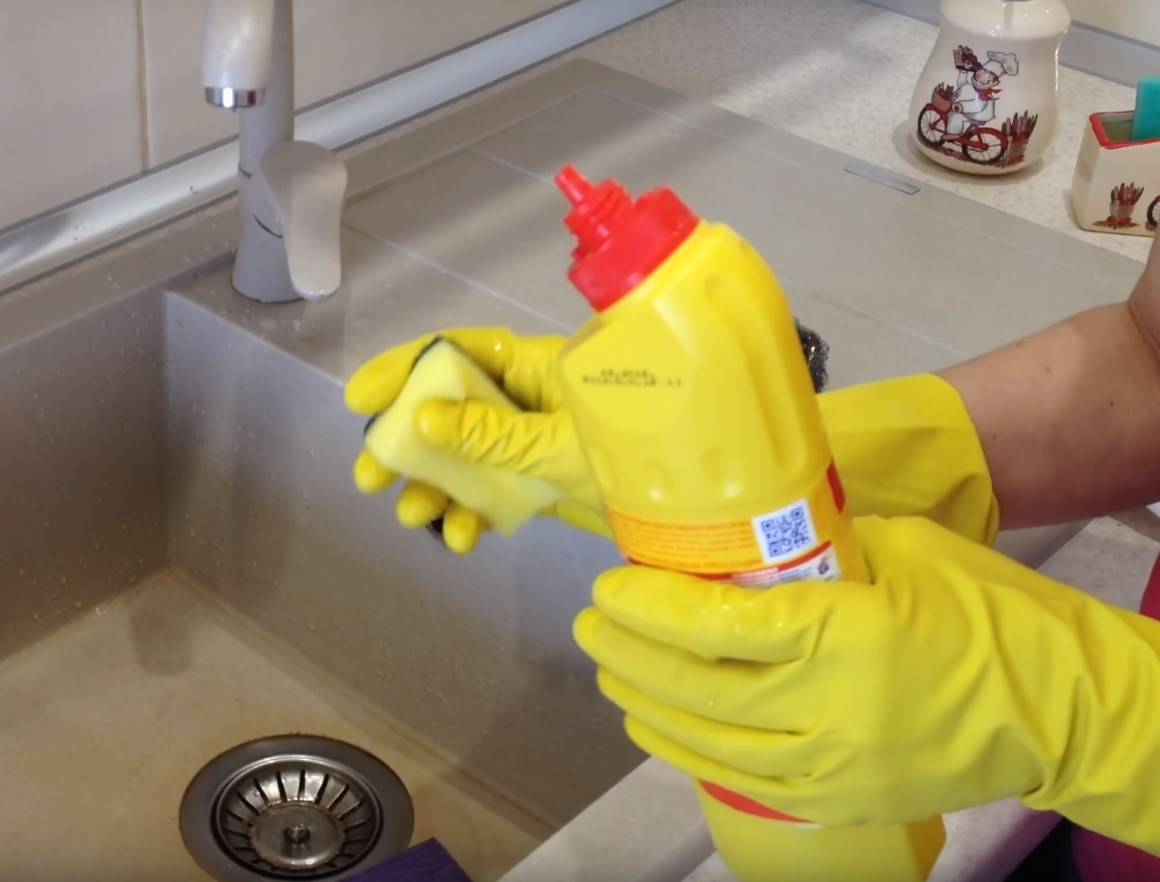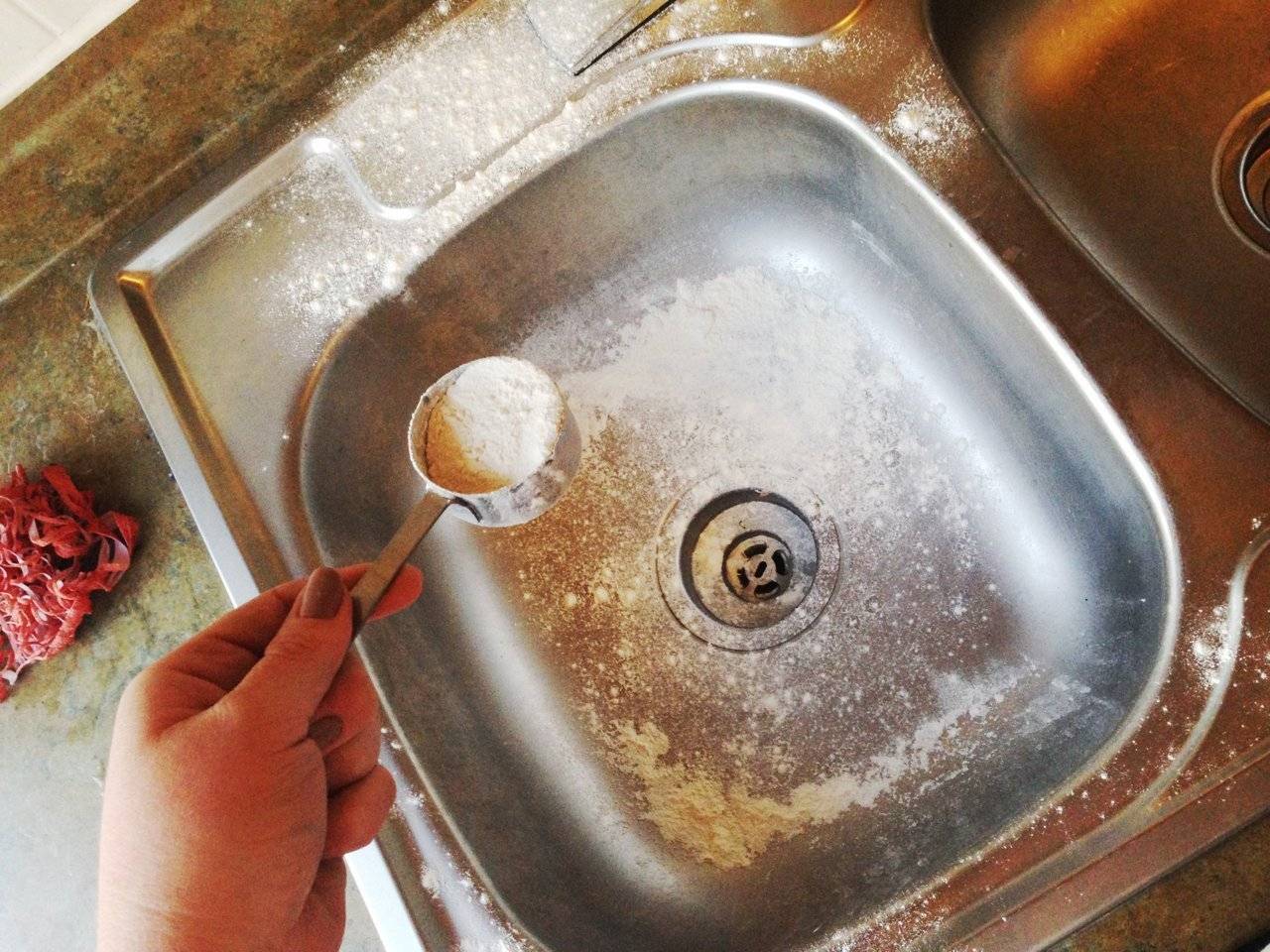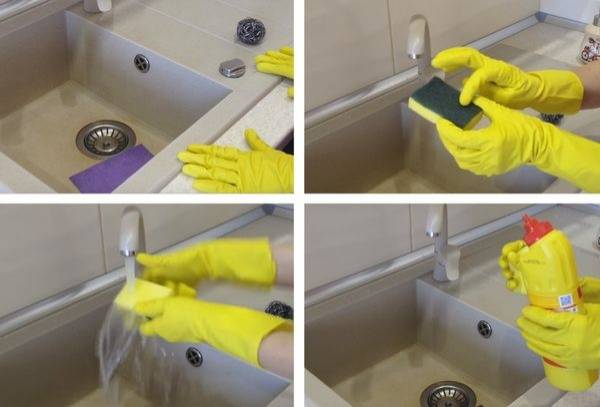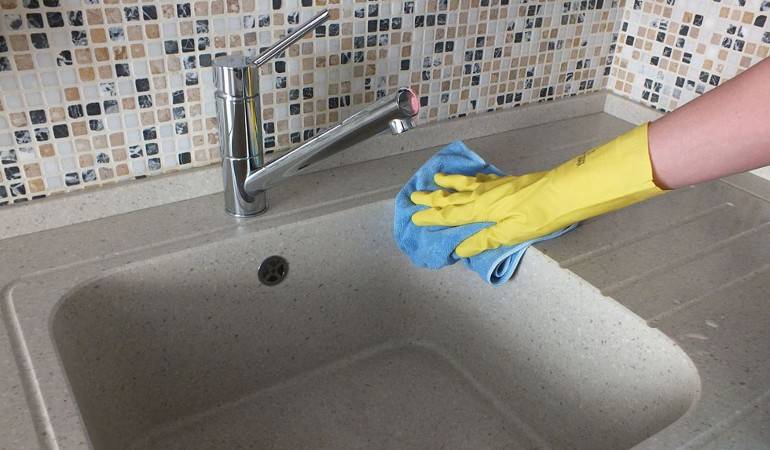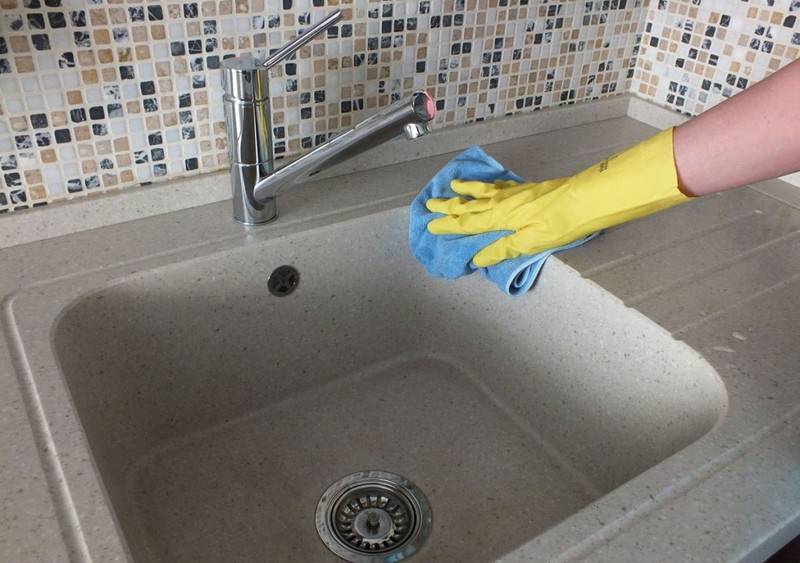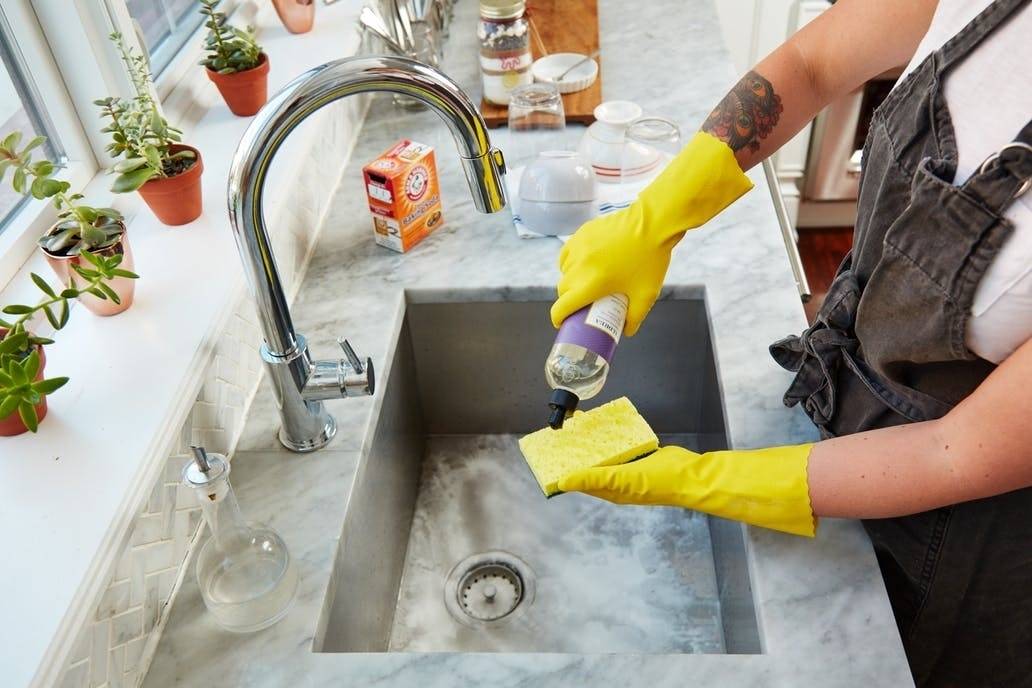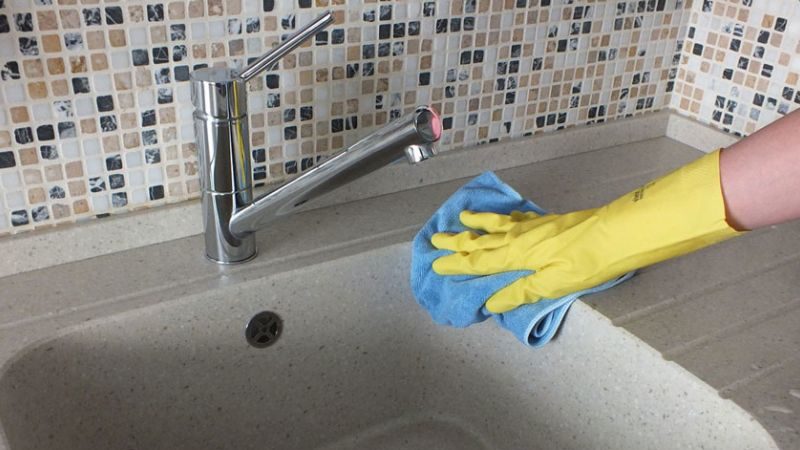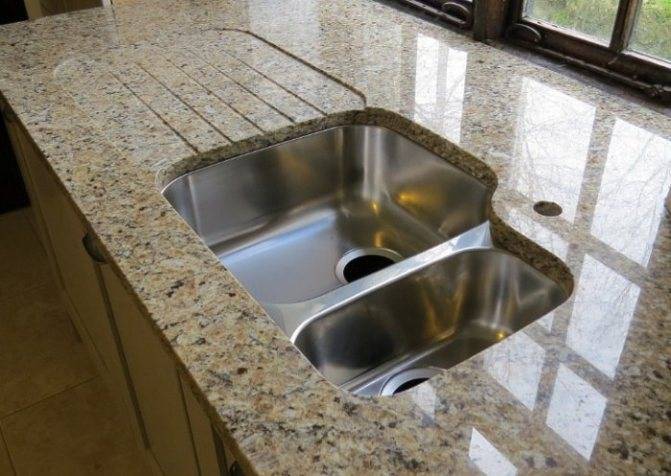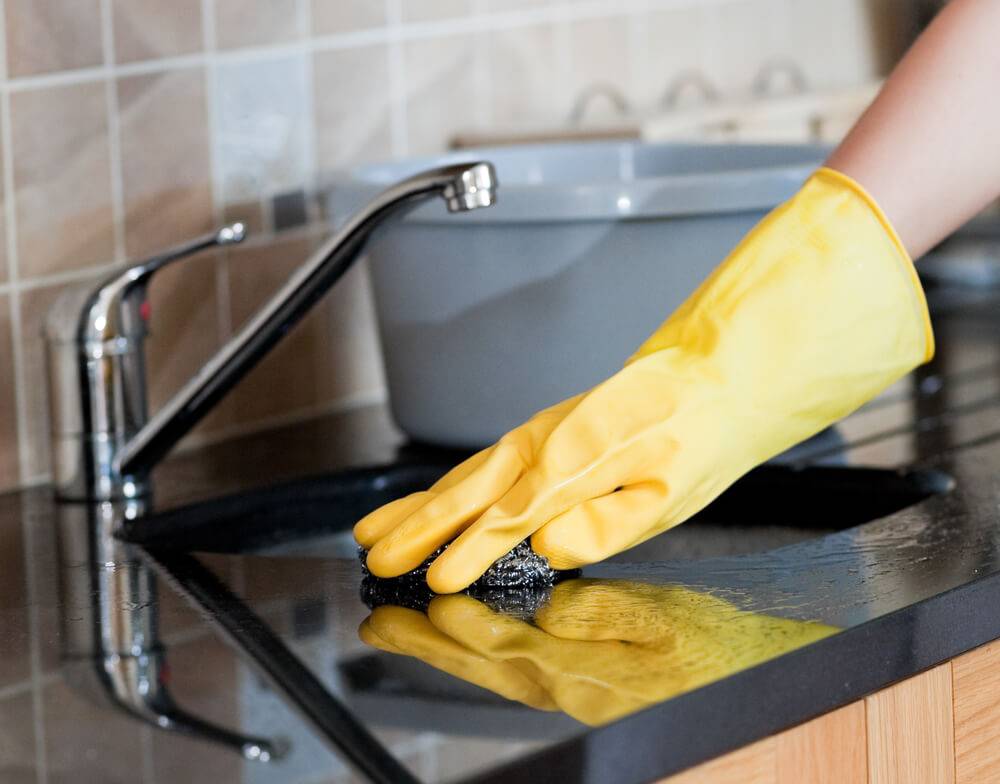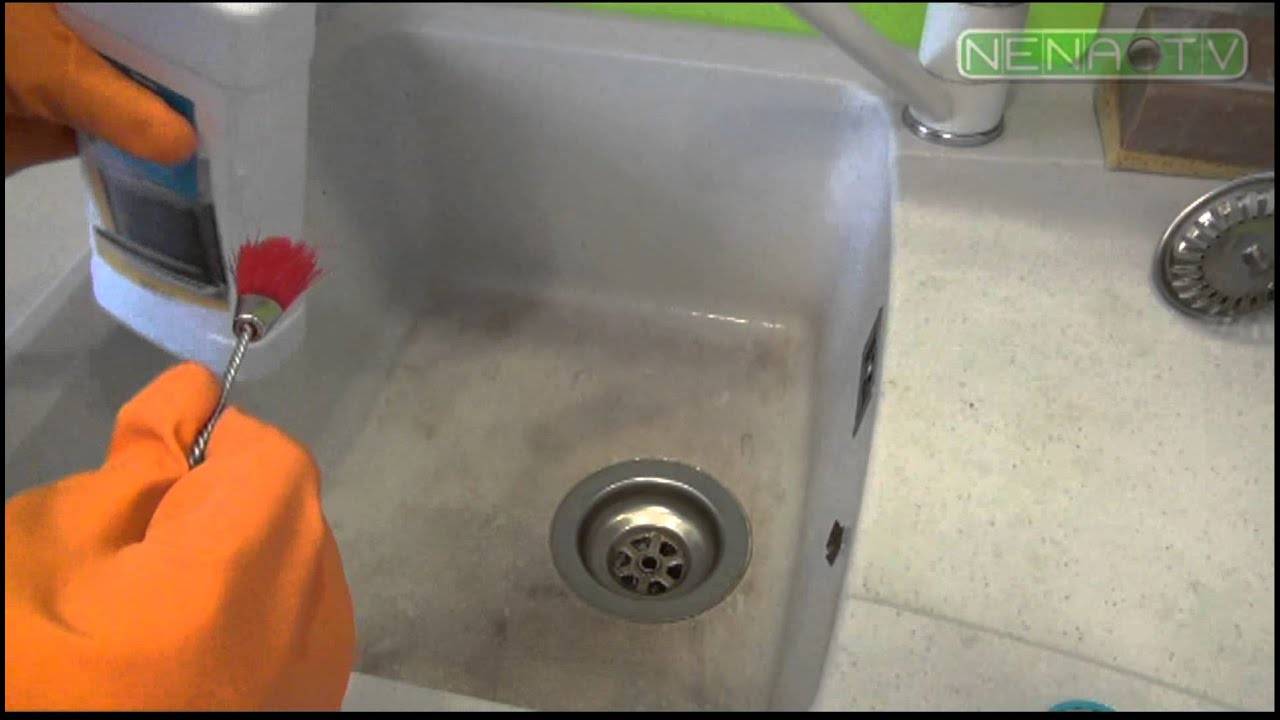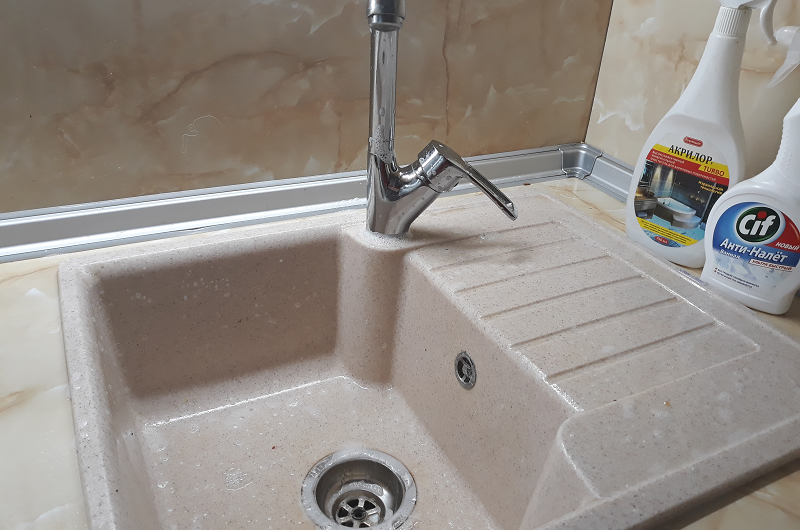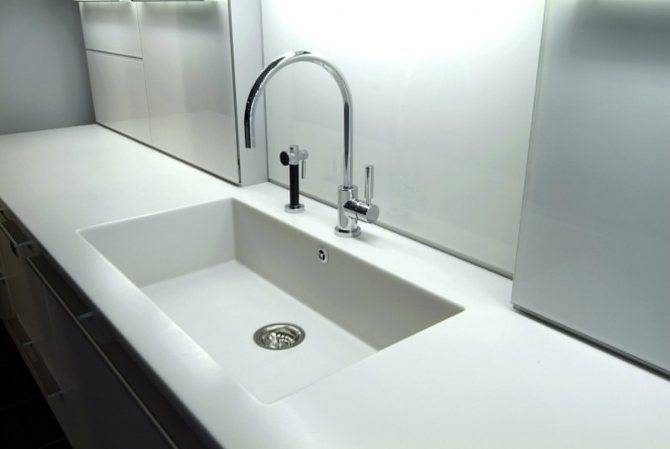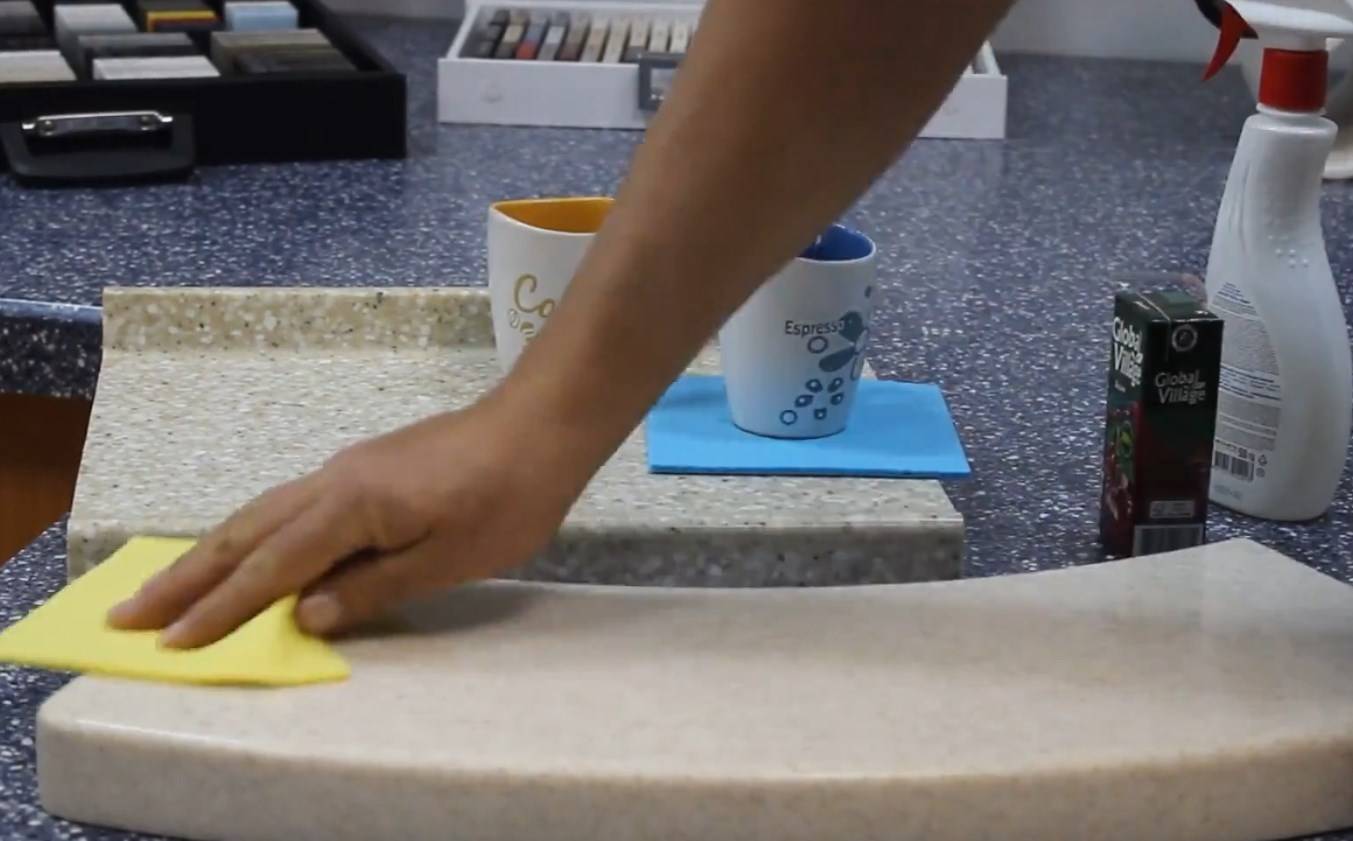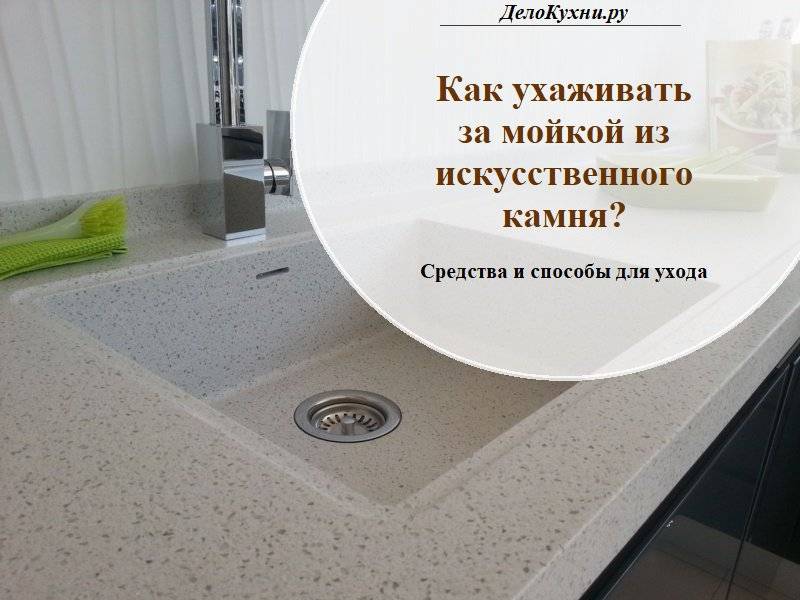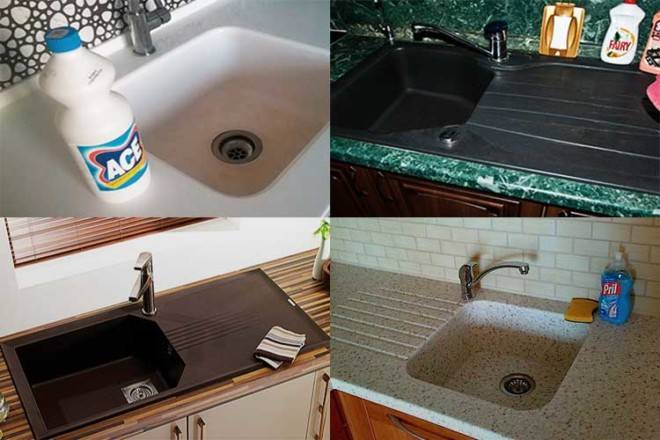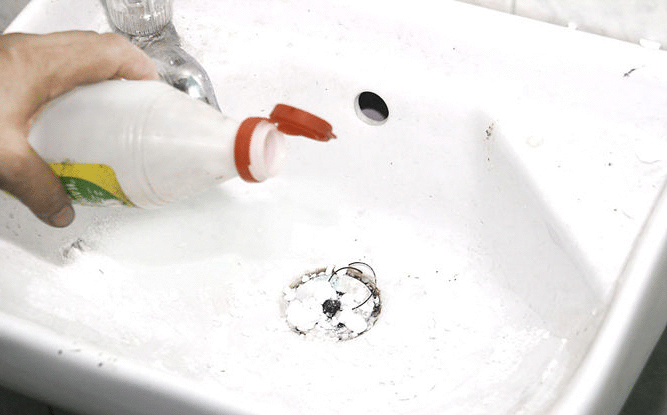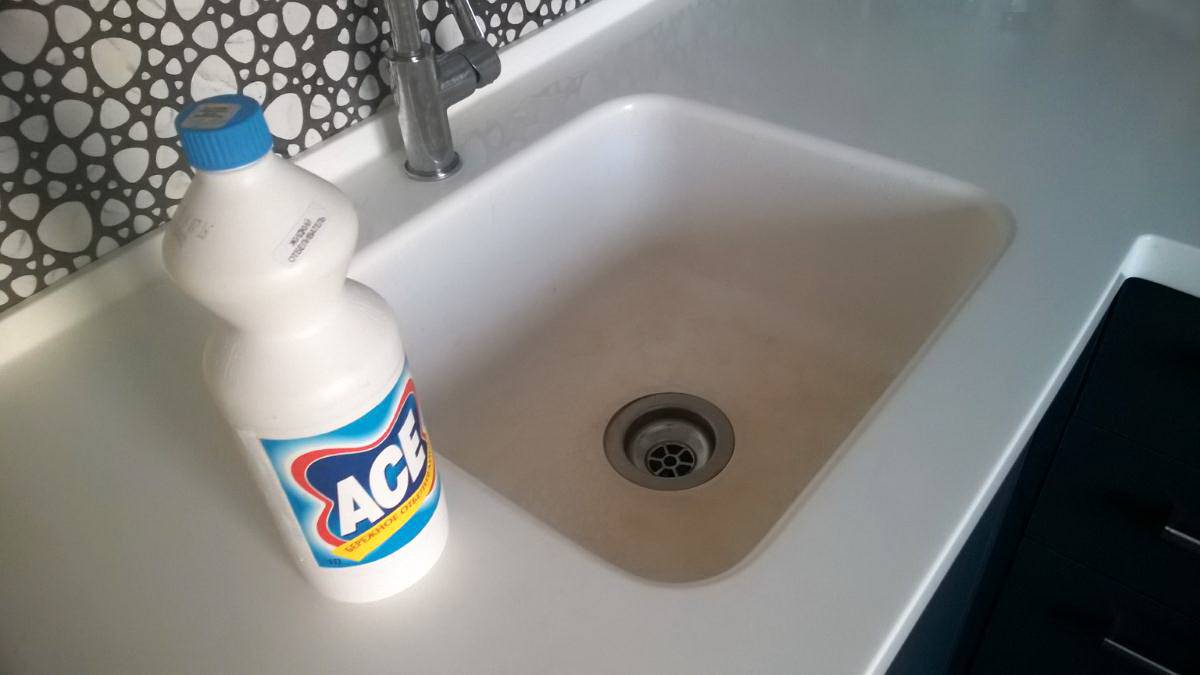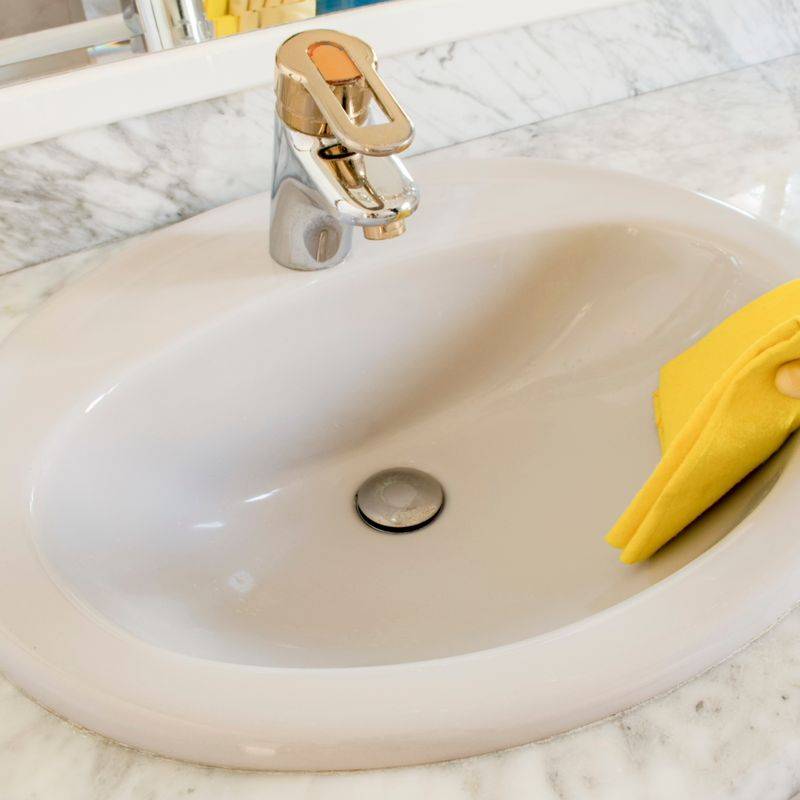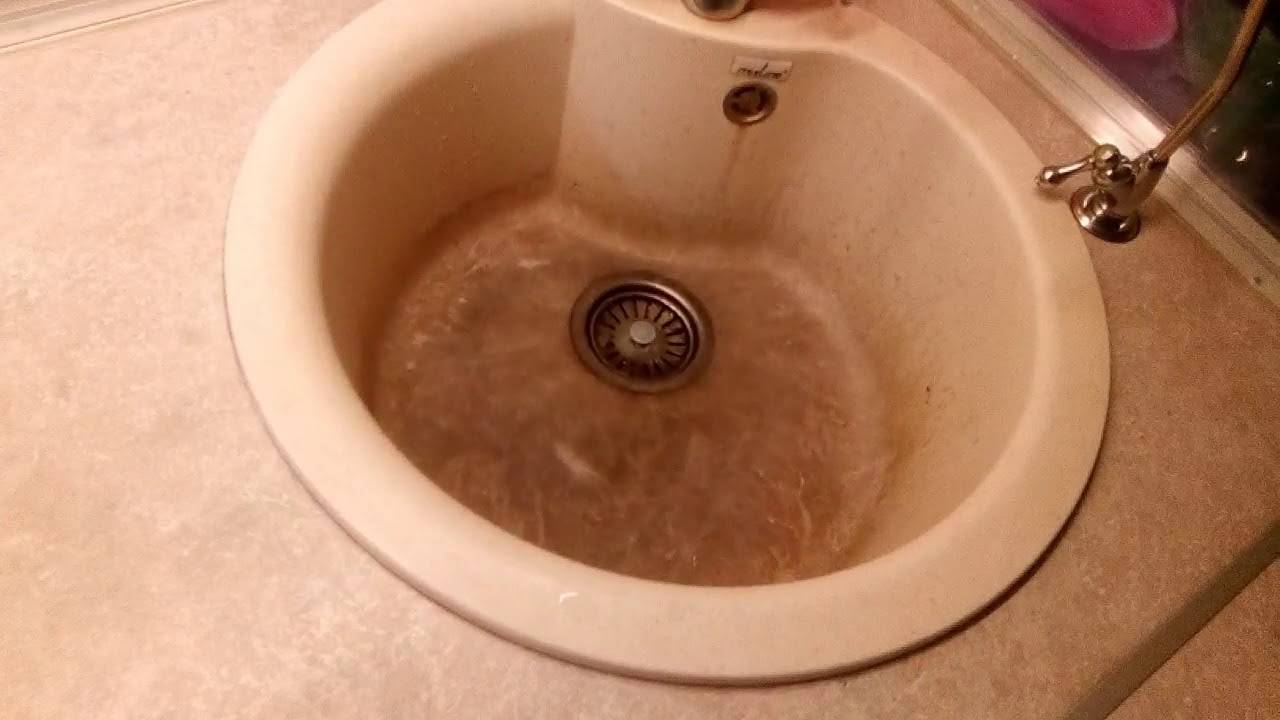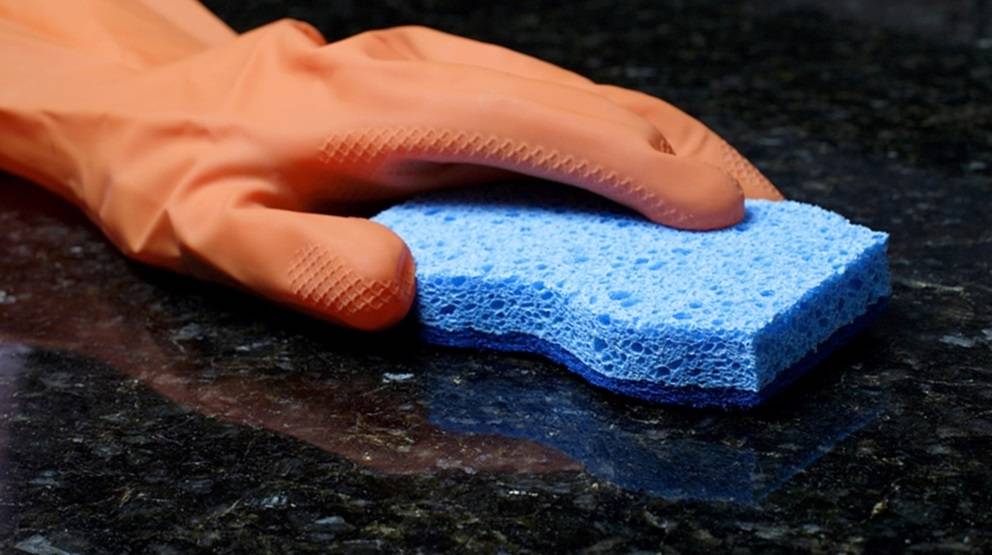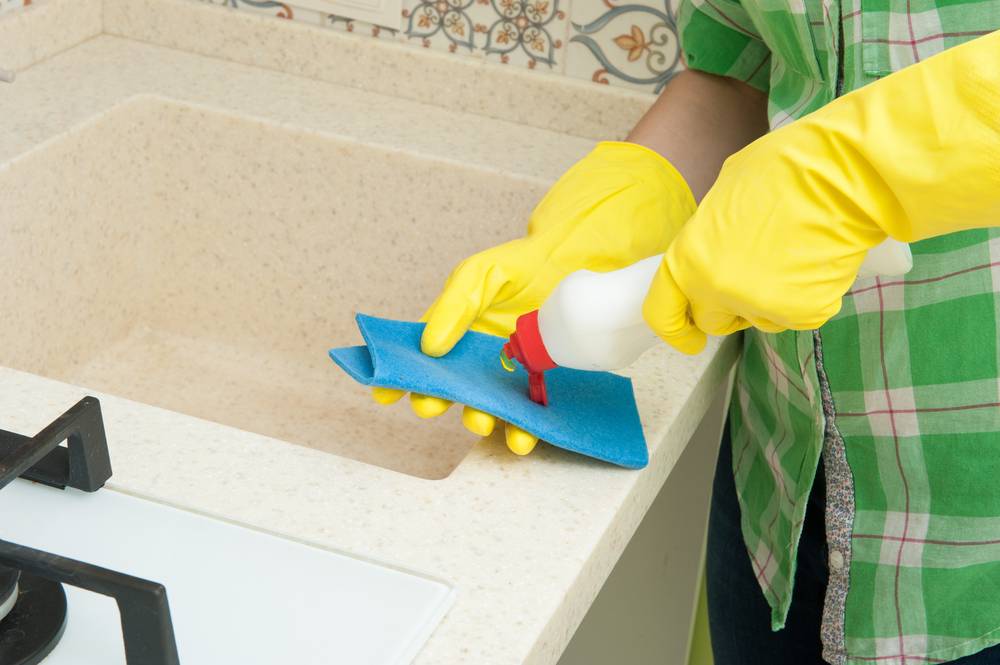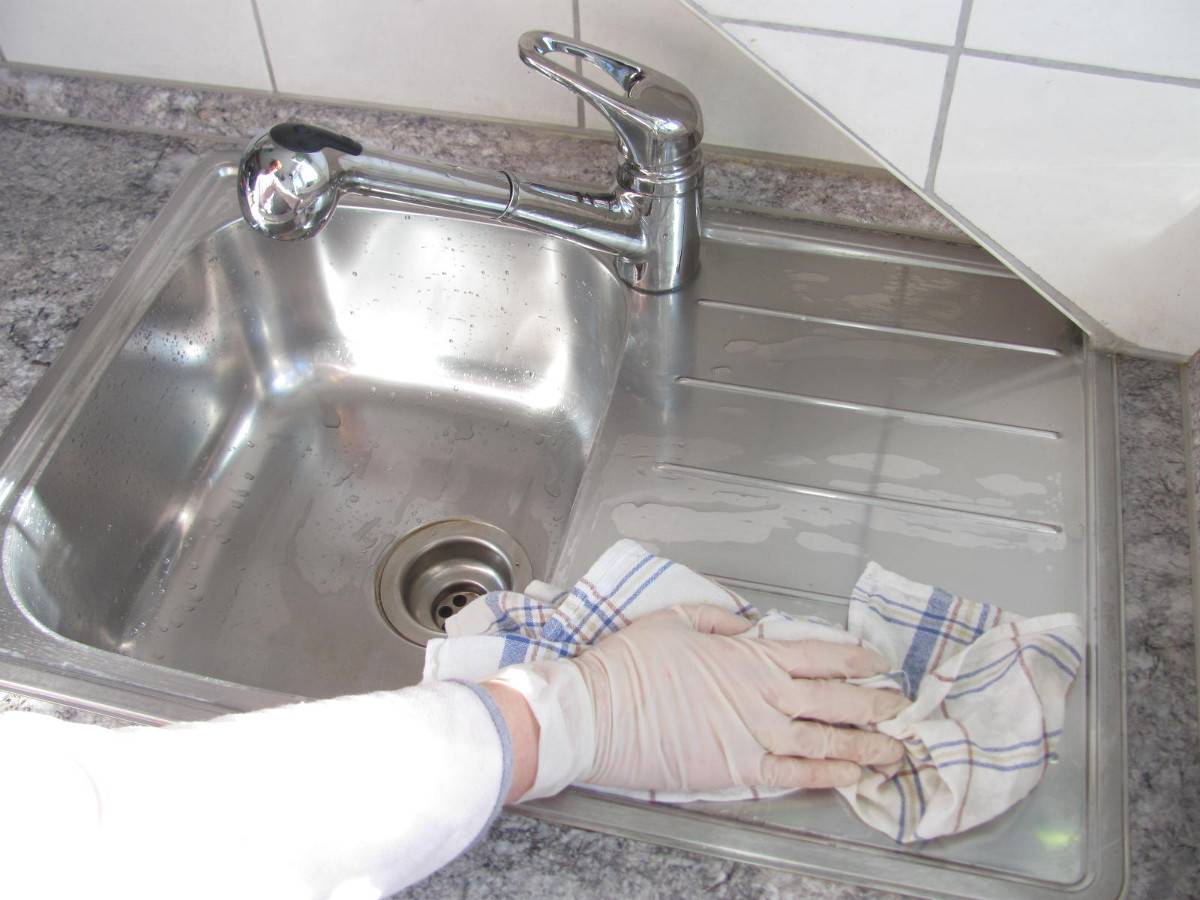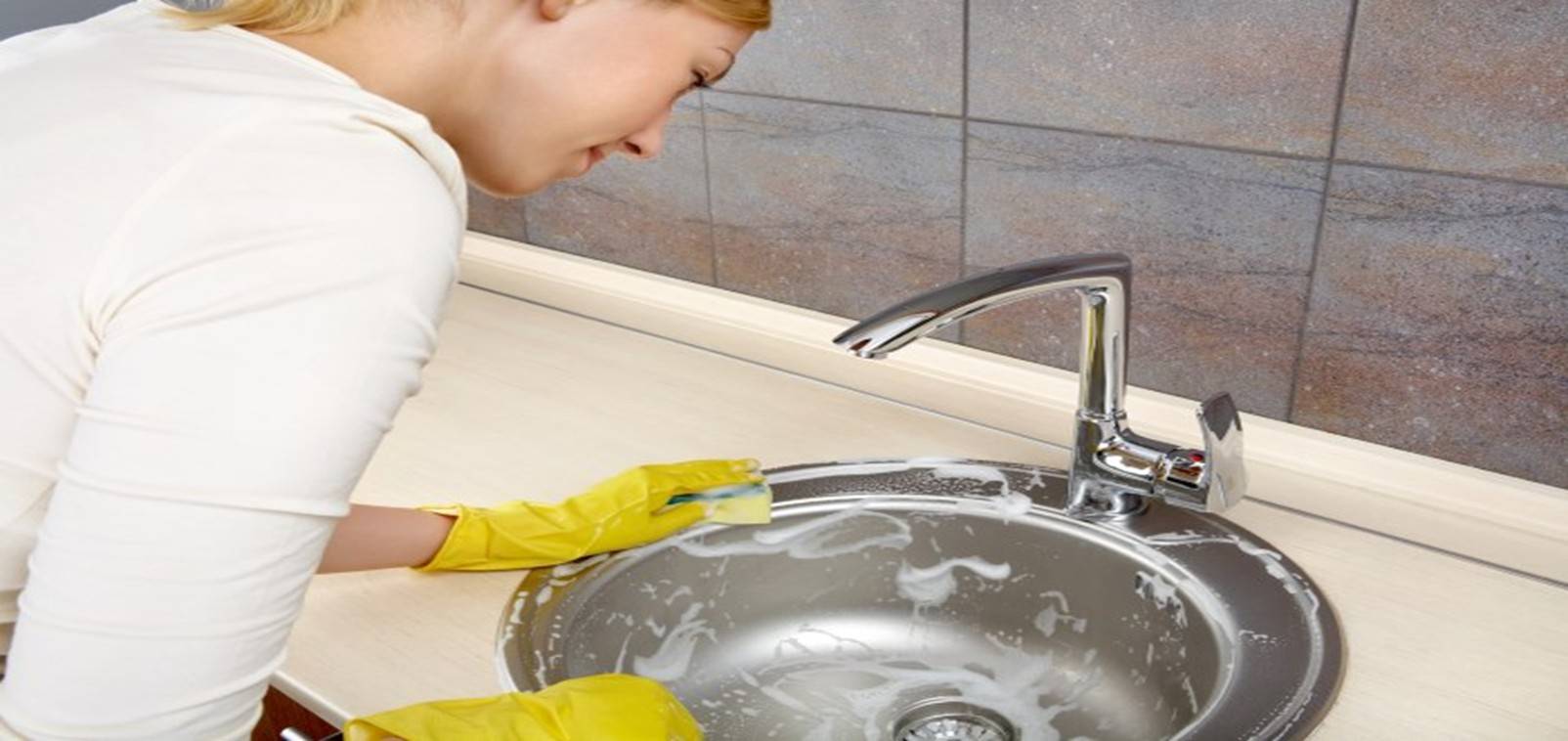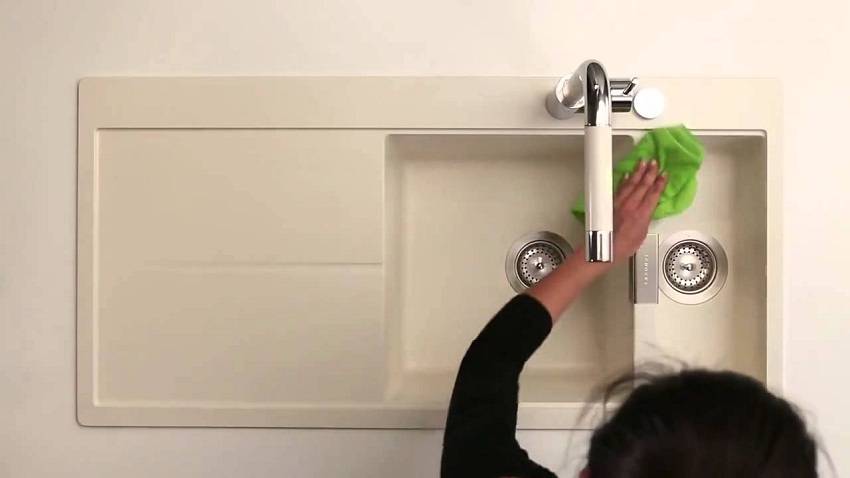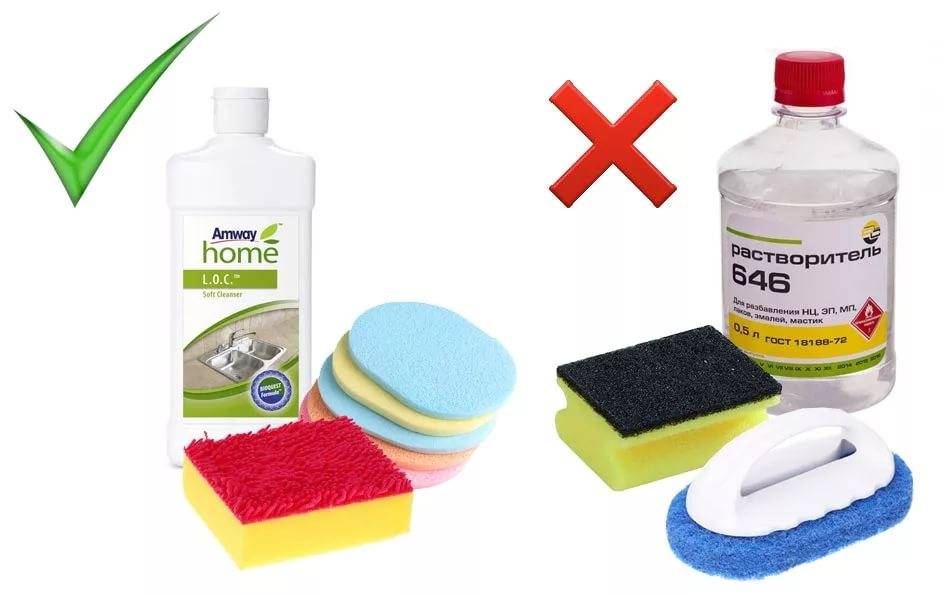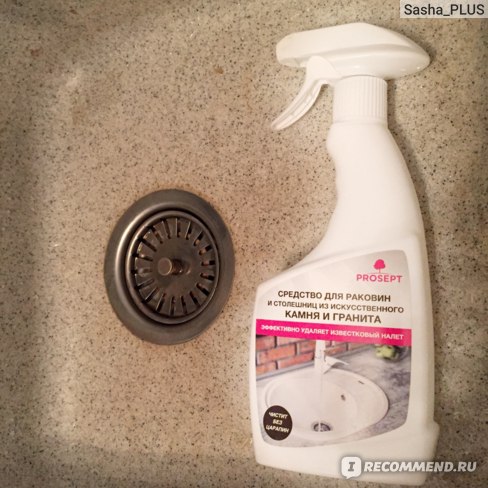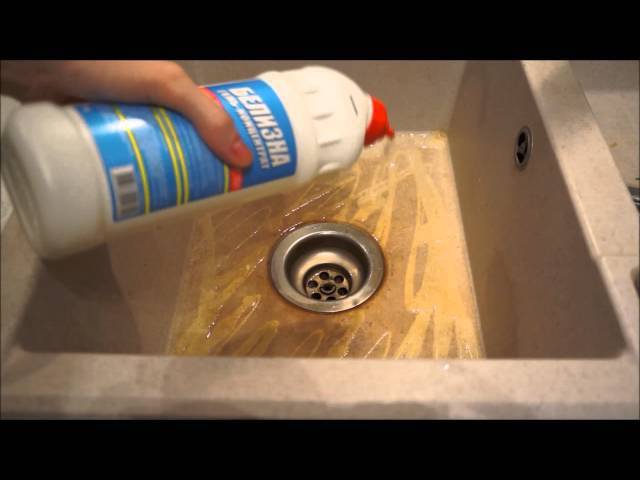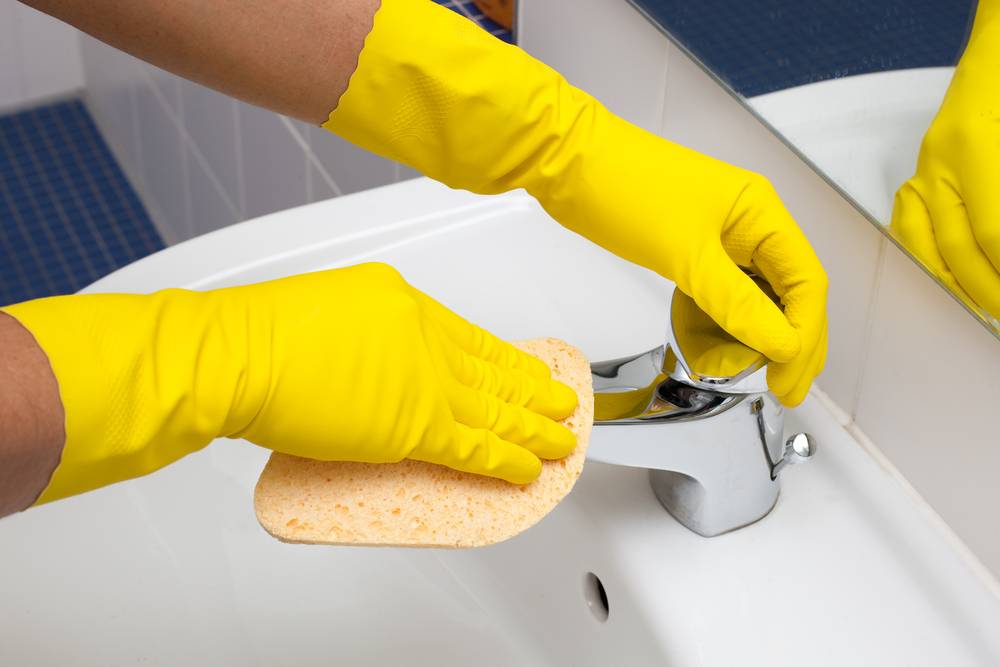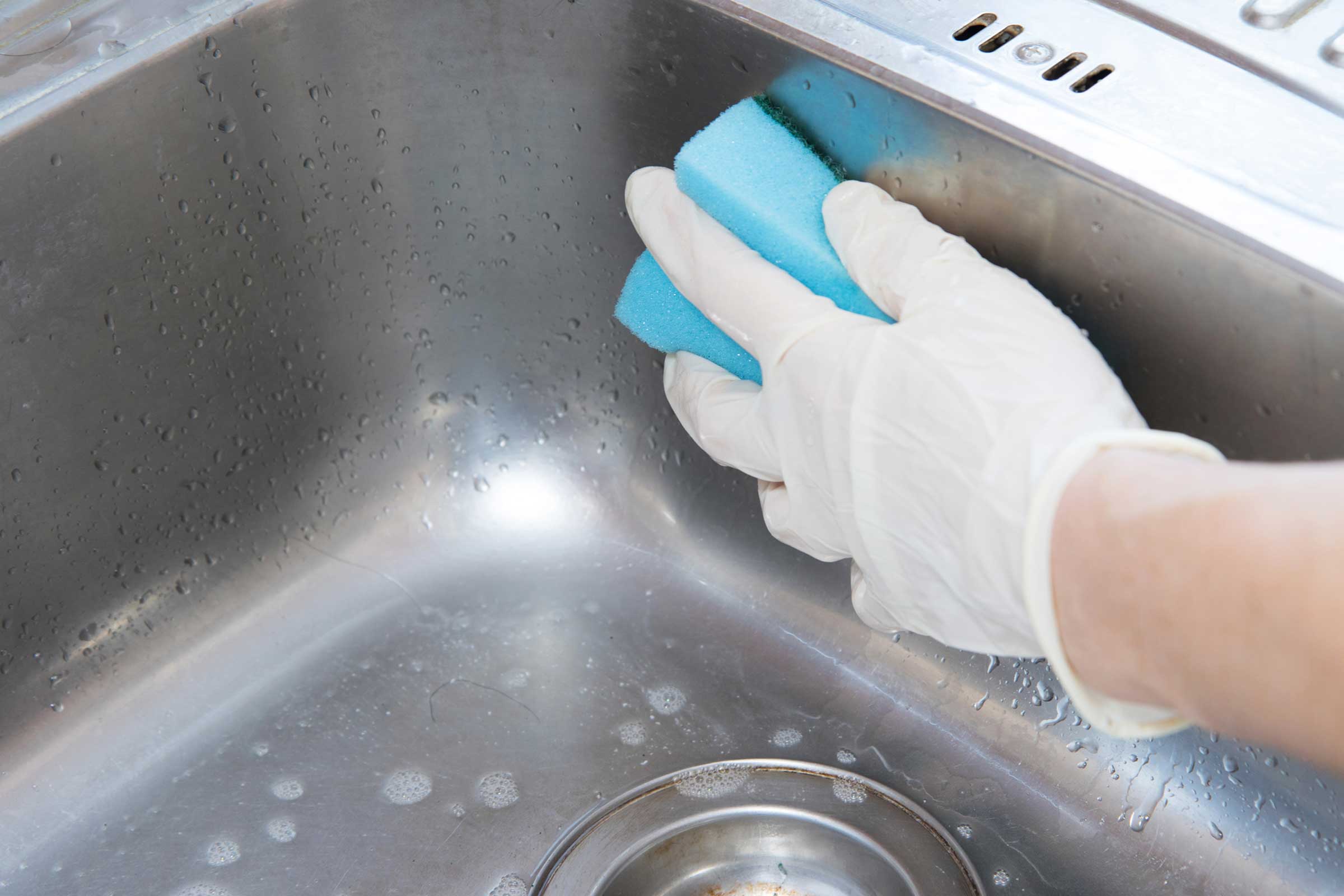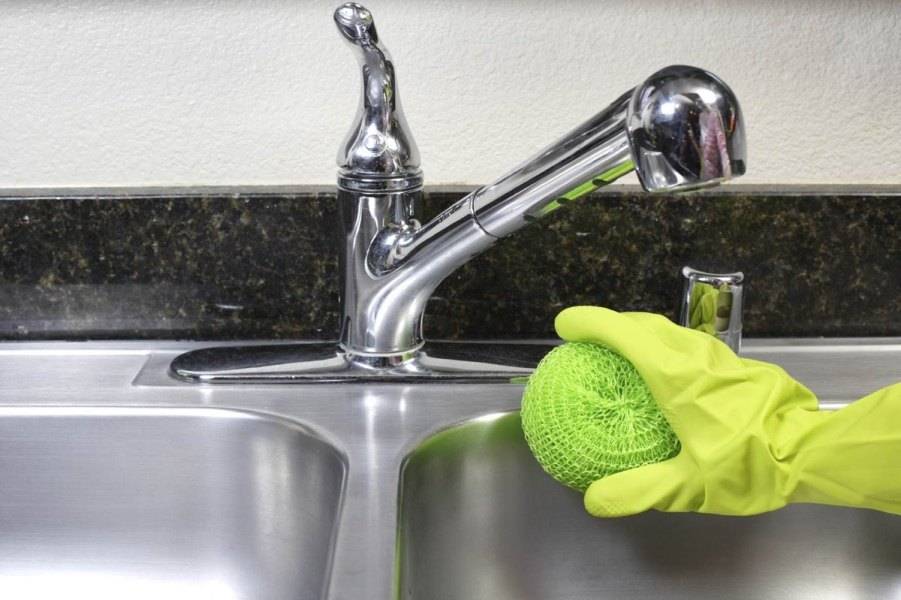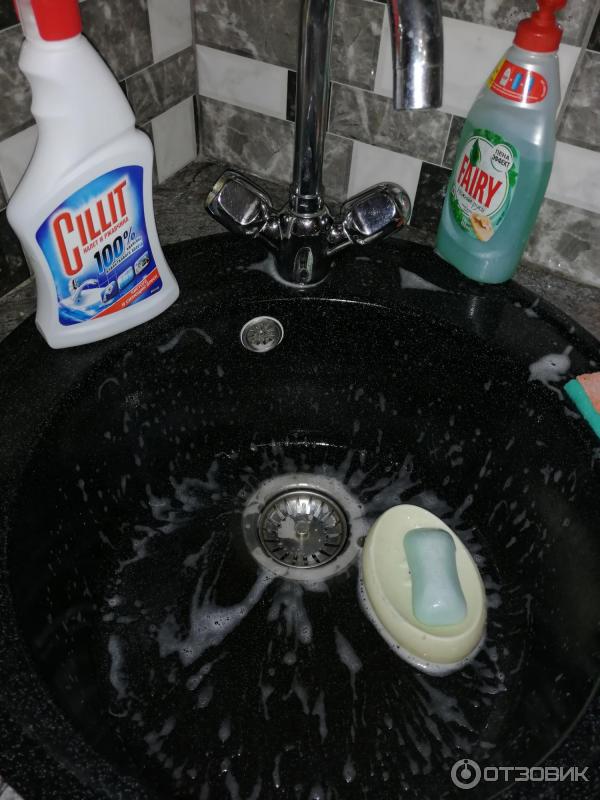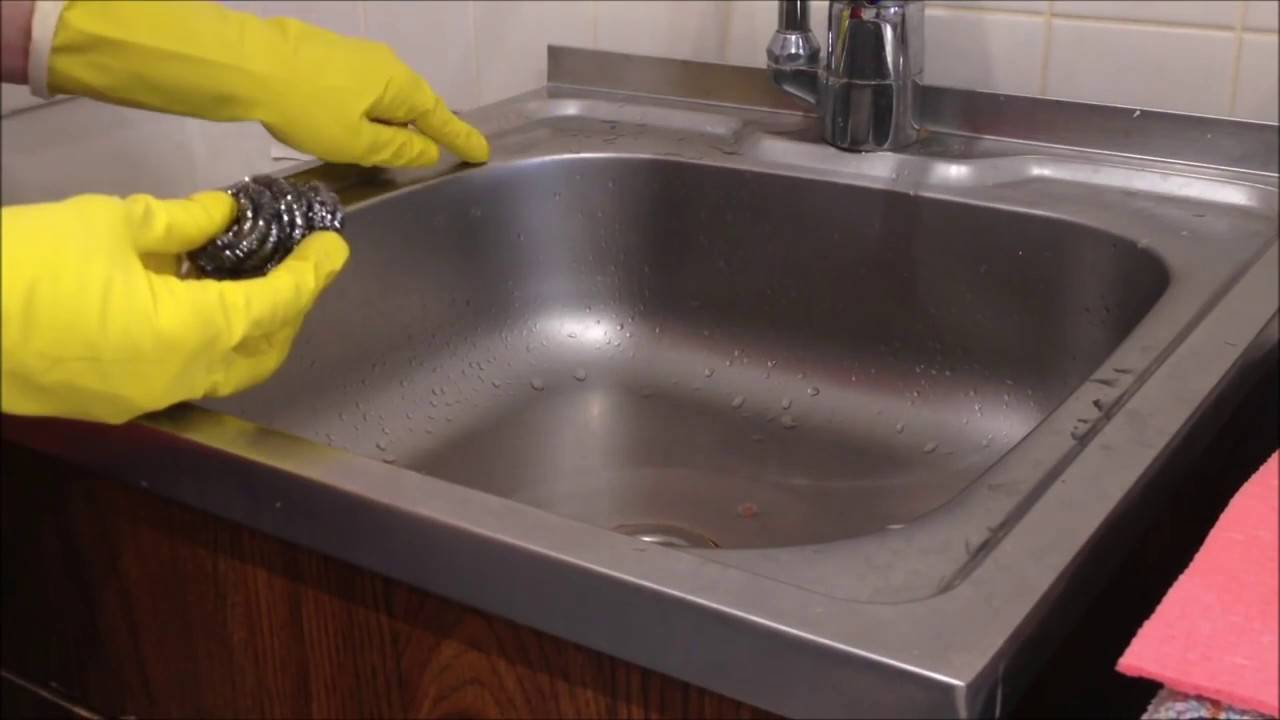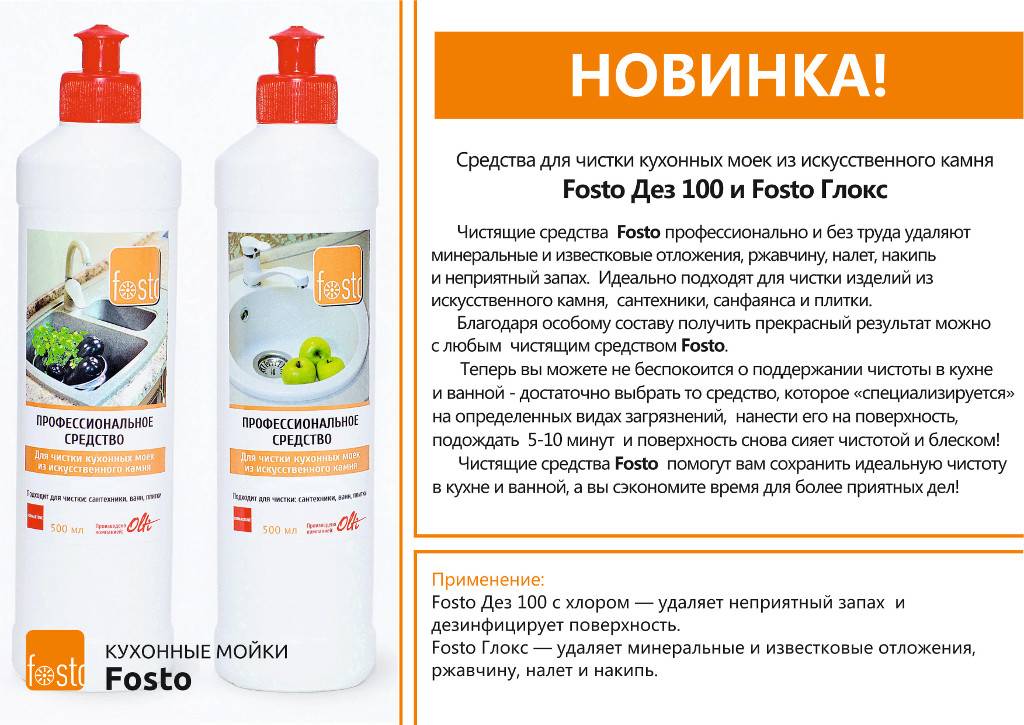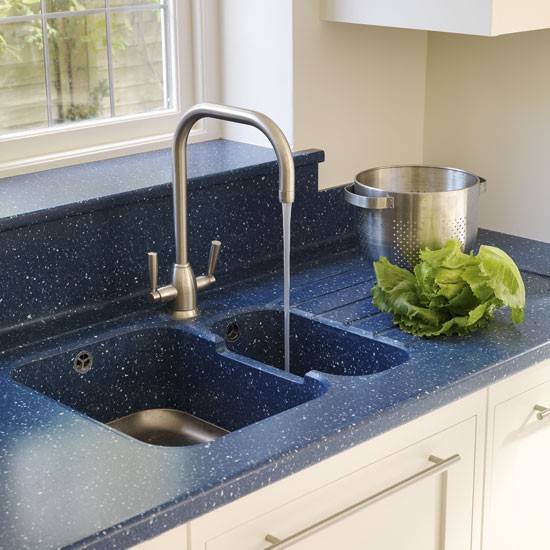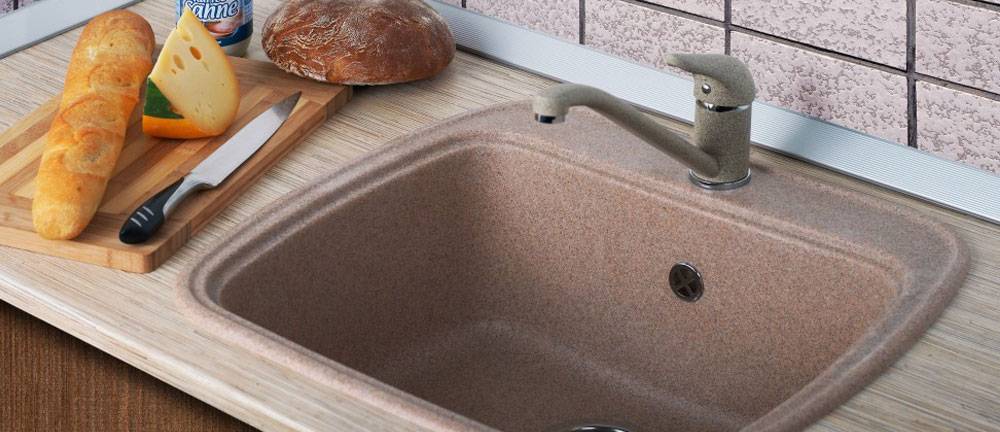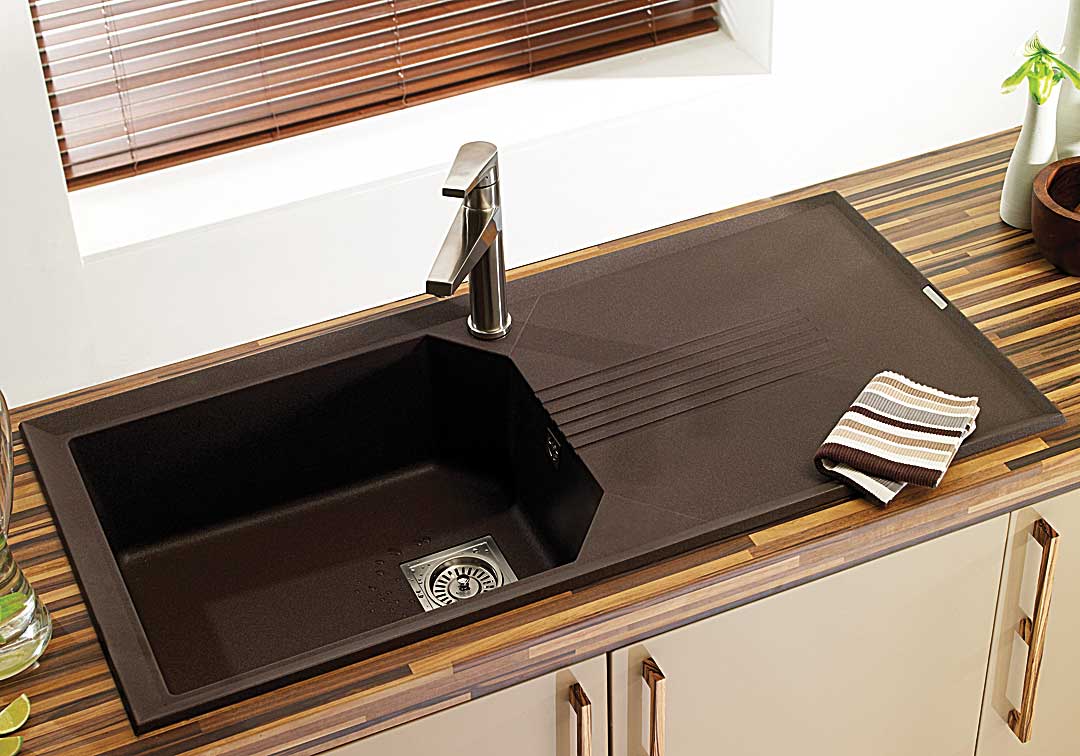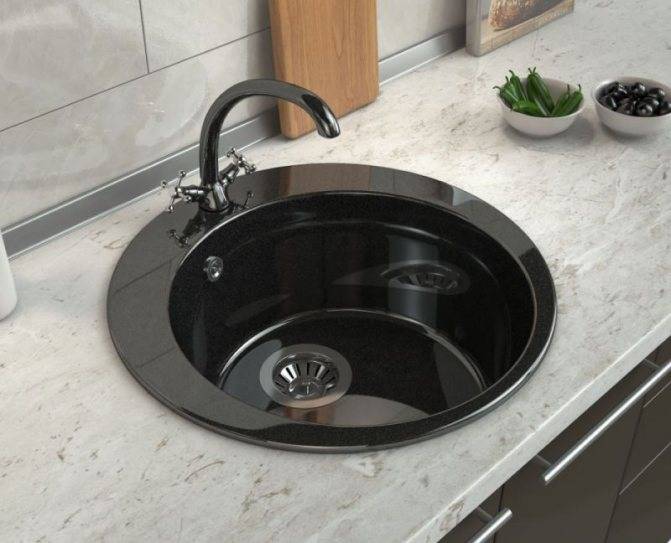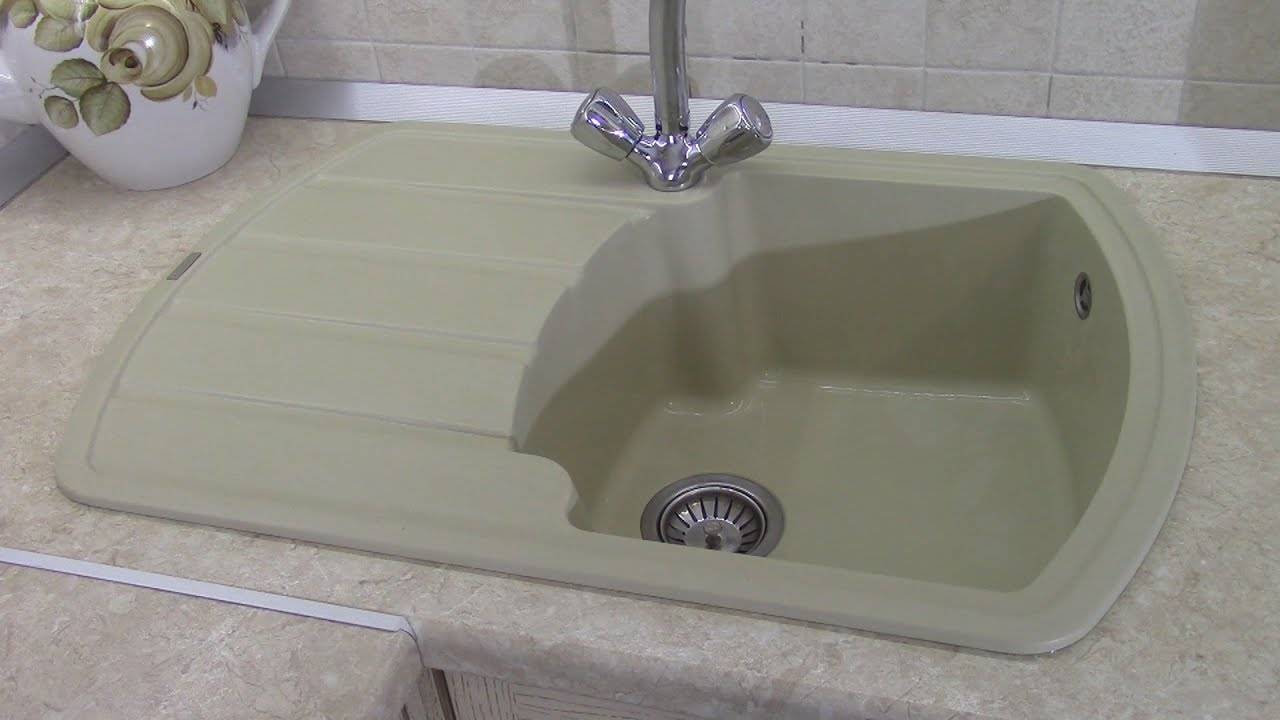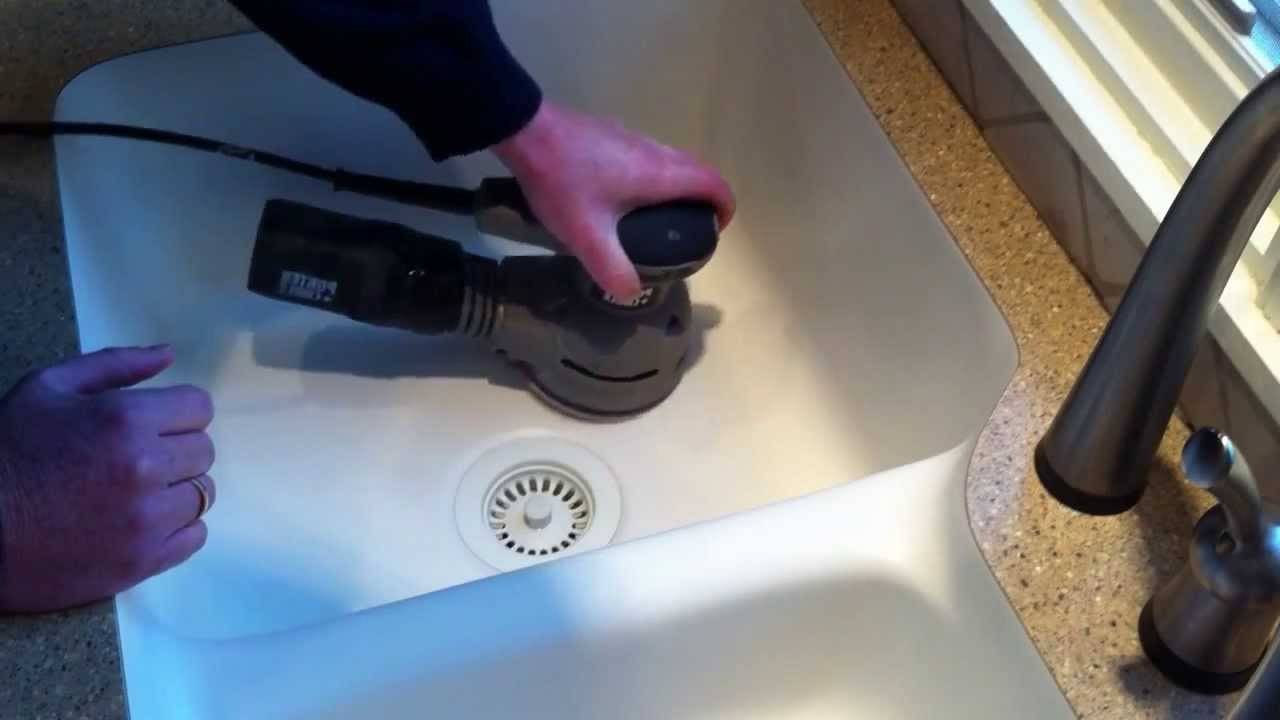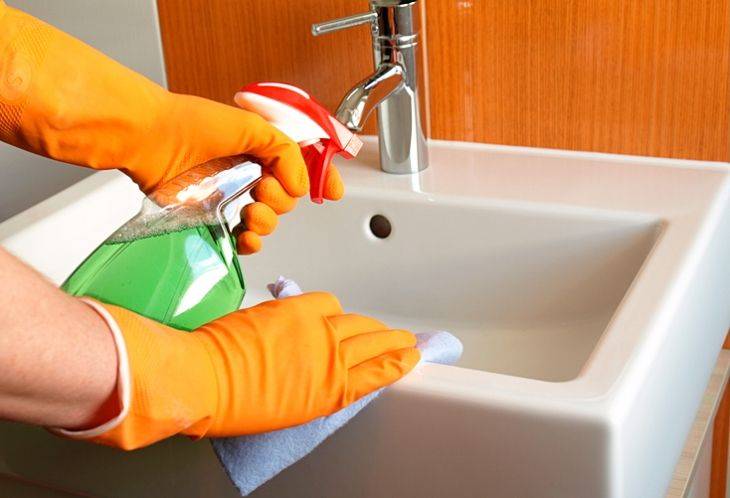Artificial stone cleaners
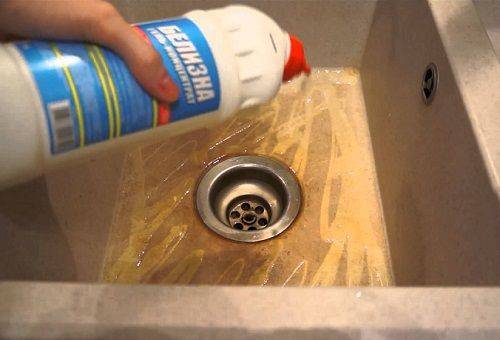
It is especially difficult to care for the surface of a light shell. For cleansing, use the following options:
- gel-like toothpaste - cleans and whitens;
- light carbonated drink, use warm;
- Baking soda mixed with water to form a paste - cleans and removes odors.
For a light stone, it is permissible to use chlorine. "Domestos", "Whiteness" - these drugs fight bacteria and whiten. The product is applied with a cloth or sprayed, left for 10-15 minutes, washed off with running water. Chlorine whitens the surface without breaking the structure and does not penetrate deep into the pores.
Substances that are suitable for light and dark sinks:
- lemon - copes with plaque and rust;
- mustard paste - effectively fights fresh dirt;
- professional liquids designed for cleaning artificial stone.
After applying the cleaning compound, the surface should be rinsed with water and wiped with a dry soft cloth. Intensive cleaning is enough to carry out 2-3 times a month, subject to systematic maintenance.
Last tips
Any problem is easier to prevent than fix. In order not to suffer from laborious capital cleaning of the sink, do the following every day:
- After washing large quantities of greasy dishes, rinse the sides of the sink with a degreasing agent.
- Dried water stains lead to the formation of limescale. Therefore, make it a rule to wipe the sink with an absorbent cloth every time after use.
- If you see a freshly appeared stain, then it is best to remove it as soon as possible with starch, soda, vinegar, bleach.
- Rubbing with wax or olive oil will add shine to the sink.
- To get rid of dried water stains, treat the surface with glass cleaner.
- Soaking dishes in the sink will quickly get the sink dirty.
Washing a sink - stone, enamel, ceramic, cast iron or stainless steel - is not such a difficult task if you know which means are most effective for this case. And also - to take care of the sink every day and not to postpone its thorough cleaning for a long "sweat".
Daily care
Any furniture, especially in the kitchen, requires daily maintenance. The same goes for stone shells. It should be noted that it is best not to treat a stone sink with strong chemicals. In addition, it is best to avoid using abrasive cloths.
To care for an artificial stone, you can use both folk and professional remedies.
If done correctly, stone sinks will last more than 10 years without losing their attractiveness.
 Wipe down the sink with vinegar every day
Wipe down the sink with vinegar every day
Home remedies
Caring for a stone sink requires careful attention, as the use of harsh chemicals will ruin the appearance of the sink. Every day, preferably in the morning, disinfection must be carried out before using the sink. To do this, fill the sink with 25% water and then add 2 cups of liquid bleach to the sink. After that, you should wait about 15 minutes. After the time has elapsed, the solution is drained, and the sink is rinsed with clean water.
The stone sink must be wiped with a dry cloth daily. This is best done at night. Of course, if desired, such a procedure can be carried out more often.
Coffee and tea leftovers are poured into the sink daily. Such drinks leave noticeable traces that can penetrate deeply into the structure of any product. That is why it is recommended to wipe the sink surface with table vinegar every day.It is enough to drop a little of the product on a sponge, and then wipe everything. Use rubber gloves before cleaning the sink.
Special means
You can take care of the sink not only with improvised means. This can be done using specialized tools. Nowadays, it is easy to find substances that can be used for daily care. Most often, housewives use:
- Cillit Bang;
- Akemi cleaner;
- PolyGran cleaning agent.
Of course, there are other products that can be used to clean sinks.
It should be noted that it is better not to mix professional substances with folk remedies, since it will be difficult to take care of the sink in this way.
Care Tips
Your sink will last longer, and you will have to clean it much less often if you follow certain rules below:

- Do not place a hot saucepan or frying pan on top of the sink
- Do not leave dirty dishes with leftover food or drinks overnight. Do not throw out the remains of tea, coffee. If spilled, rinse immediately with water.
- A leaking mixer can cause rust deposits. And the appearance of a persistent spot.
- Remove plaque and fat deposits immediately after using the sink. Don't put it off until tomorrow.
- After cleaning the sink, wipe it dry.
- Avoid hitting the surface of the product.
- A stone sink does not like sudden temperature changes. Steep boiling water and ice water.
- It is not recommended to use abrasive materials, metal sponges and brushes.
- Limit contact with aggressive acids, 90% vinegar essence, acetone, solvents.
You need to take care of the product regularly, after each dishwashing. Follow the rules, and then your item will serve you for a long time!
Preparation
Before you start cleaning your sink, be sure to do the following:
- Remove everything that bothers you.
- Be sure to wear rubber gloves!
- If you want to use chemistry, take care of airing the room in advance.
- Clean the sink of large pieces of dirt, food, hair in the sink.
- Make sure your sink brushes and sponges are not metallic - these varieties are harmful to any type of sink!
- Do not use strong acidic, chloride or ammoniacal agents - they are applicable only in small doses as part of a solution, and not in pure form!
Make it a rule to clean up with gloves
Impregnation
In order for a sink made of composite materials to be resistant to damage and not lose its luster, it must be properly impregnated. Stone surfaces react to detergents, gasoline and many other chemicals. Improper impregnation and cleaning of the sink will result in dullness and damage.
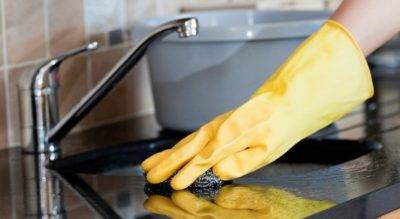
Appropriate impregnation of the sink and countertop not only strengthens the artificial stone, but also helps to protect and close the pores that appear on its surface. Small pores can absorb liquids and accelerate the deterioration of sinks and countertops, so proper care must be taken. Thanks to this, they become resistant to depigmentation, damage, cracks. The initial impregnation must be entrusted to a specialist who will select the appropriate product for these purposes. Professional impregnation should be carried out every 3-5 years.
On average, once a week, it is good to carry out additional protection of the sink. After proper cleaning, it is worth applying a layer of oil to the surface - this is sunflower or olive oil. This additional layer will protect the sink from all kinds of dyes.
Get rid of limescale and stains
Hard water and lack of regular maintenance will result in limescale stains on the sink. They are especially noticeable on dark bowls.
It is necessary to approach the cleaning of such contaminants carefully, since a composite sink, although reliable, requires more gentle handling than the usual stainless steel sink
So, a sink made of artificial stone in the kitchen cannot be cleaned with abrasive products and liquids containing a high percentage of acid.
To get rid of white stains on the black surface, ordinary lemon juice will help, which you need to grease the stain, and after a short period of time (about 10 minutes) rinse it off.
Not too old plaque can be removed with a gel-based toothpaste or baking soda mixed with water.
For owners of light-colored sinks, the problem of rust stains that appear from dripping water or a leaking faucet is more relevant. The same soda helps to cope with yellowness and rusty stains.
A gruel of sodium bicarbonate and warm water should be applied to the stain, held for a while and rinsed off. If necessary, you can rub the stain with a sponge or soft cloth.
Among the tools that can be used to clean a stone sink in the kitchen, soda occupies a special place. It has a high percentage of food acids that dissolve rust, which is why the drink has earned the reputation of a cleaning agent. Coca-Cola is best suited for these purposes.
Limescale and stains are frequent guests in areas where water is constantly used. Plaque is especially noticeable on a black surface. How to clean a stone sink in the kitchen?
You can remove dirt with bleach, bleach or special products for cleaning artificial stone products. The chlorine solution is able to cleanse a light sink from bright spots and return it to its original appearance. In addition, these remedies can help solve the problem of unpleasant odor. After use, it is necessary to thoroughly rinse off their remnants and wipe the surface of the product dry.
You can remove dirt with bleach, bleach or special products for cleaning artificial stone products. The chlorine solution is able to cleanse a light sink from bright spots and return it to its original appearance. In addition, these remedies can help solve the problem of unpleasant odor. After use, it is necessary to thoroughly rinse off their remnants and wipe the surface of the product dry.
If you do not allow the formation of stubborn stains, making regular maintenance of the sink made of composite material, it is not difficult to cope with dirt in the form of dark and yellow spots, plaque.
Even if you accidentally scratch a capricious sink made of artificial stone, this nuisance can be eliminated.
Dark spots
Dark stains, tea and coffee traces can be removed with dish gel if the dirt has not had time to stick into the surface structure. The detergent should be applied to the hard side of the sponge and rubbed over the problem area.
Vinegar and baking soda can whiten and clear dark spots on light colored surfaces.
Limestone bloom
Limescale will easily dissolve a slice of lemon sprinkled with salt. To do this, put some fine salt on a piece of citrus and rub the places with sediment. After fixing the problem, the product must be washed with clean water, wiped dry with a soft cloth.
For stubborn lime stains, which are especially noticeable on black faux stone sinks, you can use Cillit BangTurbo Power, an oxalic acid spray.
Scratches
Removing scratches:
- A small amount of baking soda is applied to the green scotch-bright abrasive. Instead of "scotch-bright", you can use sandpaper. For significant scratches, grit P120 is used. For minor damage, you can purchase paper with a grain of P180, P220 or P320. It all depends on the depth of the scratch. Finish the leveling by grinding with a fine grain P400 or P600.
- The damaged area on the product made of artificial stone is rubbed with a sandpaper in a circular motion. In the process of grouting, it is necessary to monitor the condition of the scratch.For numerous scratches, a sander is used.
- When the damage is aligned with the common surface, the area is washed off with water.
- The treated area is covered with a detergent containing ammonia. In its absence, you can use any household chemicals without abrasive particles. The product is left on for 5-10 minutes.
- With the soft side of the sponge, wipe the treatment site, rinse with water.
- Wipe the entire sink dry with a soft cloth or rag.
Removing scratches
Improper use and not too gentle care contribute to the appearance of cracks and scratches on the sink, which spoil the look and create additional obstacles when washing the bowl.
Serious chips and cracks require professional intervention. There are special workshops that carry out the reconstruction and repair of stone sinks.
Small scratches can be repaired at home. The choice of materials and methods of struggle depend on the surface finish:
- if the sink has a matte finish: apply baking soda to a moistened skin (abrasive sponge), wipe the scratch area with it and rinse with water. Deeper damage is eliminated with sandpaper (first you need sandpaper No. 240, it needs to carefully handle the scratch, and the final grout is carried out with No. 80);
- if the sink is glossy: small scratches should be treated with liquid with ammonia and rubbed in a circular motion with a soft sponge. Then rinse off the product and wipe the sink dry. Next, you need to apply a special polishing mixture to the surface without silicone additives and citrus extract. Deep damage will have to be cleaned off with a grinder with different attachments: from larger (for grouting) to shallow (for polishing).
In the household chemicals market, there are professional repair kits designed to work with serious damage. For example, GOI paste based on chromium oxide, epoxy glue, putty. Having carefully studied the instructions for their use, you can cope with the repair of the sink on your own.
Such a defect is eliminated quite simply in several stages:
- cleaning the damage with sandpaper;
- filling the scratch with special glue;
- sanding with sandpaper;
- surface polishing.
If the scratch is shallow, then it will be enough just to polish it with sandpaper.
Sooner or later, even with careful use, scratches form on the surface. This mainly applies to acrylic sinks, granite sinks are much more durable. How to restore the original look?
Sandpaper
In cases with large scratches or other deep damage, you can use sandpaper of various grain sizes, preferably moisture resistant. First, we take fine-grained emery cloth for primary grinding — from 200 to 125 microns, we finish with a zero finish of 80-40 microns. During processing with sandpaper, you need to moisten the surface with water, this will achieve a more delicate sanding. Ideally, after sanding paper, you need to polish with GOI paste or use a colorless car polish.
There are many cleaning products on the household chemicals market that can update a thing.
- Сillit Bang. Chlorine-based anti-stain detergents.
- Sanfor white. For light sinks
- BIOSOL Na6 Especially for granite stone sinks
- Akrylan premium from Bugy
- Chlorine-based bugs ceramite.
- Akemi Several different cleaners. From mild soap to intense cleanser.
- Shumanite cleaning agent for granite stone.
- Prosept Cooky spray
Video
You can clean a stone sink at home with the help of improvised means or special household chemicals. The following videos will help you to understand the nuances of cleaning:
About the author:
Found a bug? Select the text with the mouse and click:
Do you know that:
The habit of using the washing machine "sparingly" can lead to an unpleasant odor in it. Washing at temperatures below 60 ℃ and short rinses allow fungi and bacteria from dirty clothes to remain on the inner surfaces and actively multiply.
How to clean a stainless steel sink
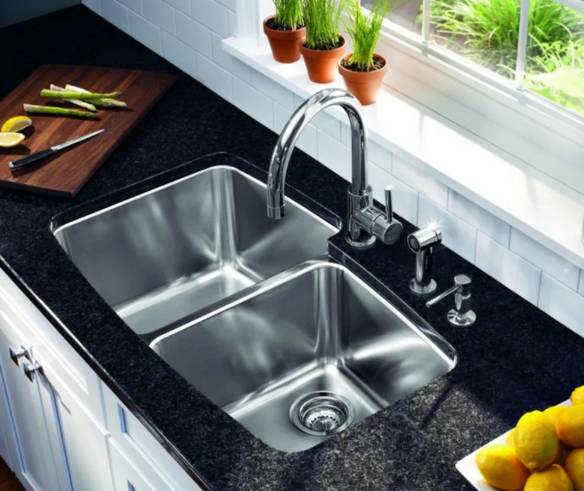
Stainless sinks are still the most popular type. First of all, they attract users with their unpretentiousness, practicality and durability. However, in order for a stainless steel sink to always look perfect, it also needs some attention to itself.
Basic daily maintenance of the steel surface is simple - you just need to wipe it dry after each use. Otherwise, drying splashes of water leave untidy whitish spots on it.
All kinds of napkins, sponges, paper towels, as well as other similar household products for dry or wet cleaning are suitable for wiping a stainless sink. For cleaning - brushes with hard synthetic bristles. At the same time, to remove even the most stubborn dirt, you should not resort to using coarse metal brushes, as they are guaranteed to leave scratches.
To wash away the thick grease from the walls of the sink, it is necessary to shut off the drain and fill it with hot water and detergent. The softened fat is cleaned off with a hard sponge or brush, then the bowl is emptied and rinsed with clean warm running water.

You can use a toothbrush to clean hard-to-reach areas of a stainless sink, such as the faucet area.
First, apply a concentrated detergent or baking soda paste to the area to be treated. After about 30 minutes, the softened dirt should be easily removed. If this does not happen, then the pollution is of mineral origin. Repeat the procedure, but using citric acid gruel.
If the walls of the sink have a smooth surface structure, then their shine can be easily restored by wiping with a napkin moistened with a solution of vinegar.
Artificial stone properties
The material for making sinks is artificial stone, it is an analogue of natural stone, but more practical, it is possible to make sinks of various shapes and colors from it. To create this material, crumbs of natural granite, marble are used, to combine this material into a single whole, polymer components are used.
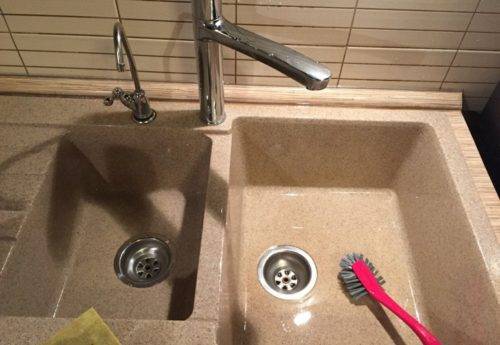
Thanks to polymers from granite chips, a hard, durable and reliable material is obtained, into which dyes are added to give the desired color and shade. Then a product is applied to the material that protects the surface, it fills the pores and a smooth coating is obtained. Main material properties:
- High resistance to temperature drops.
- This material is not afraid of water and moisture.
- Beautiful appearance thanks to the additional protective coating.
- It is easy to give any shape and size, which is a plus, when making sinks for a design project.
- All products from this material can be produced using a seamless method.
- The material is easily cut with ordinary tools, so it can be easily chased to the size of the tabletop.
- Solid, plastic, appearance is completely identical to natural stone.
- When washing dishes, there will be no noise and ringing.
- Withstands high temperatures, low flammability of the material.
Important! In case of contact with the surface of a product made of acetone, alkali or acid, immediately rinse the surface with plenty of soap and water and wipe the surface with a microfiber cloth.
How to clean your sink properly
Daily cleaning of your sink is quick and easy with regular soap or dish detergent, or a specialized artificial stone cleaner. Mustard powder is also suitable for daily cleaning.
First remove dishes, food debris and other foreign objects from the sink. Then apply detergent to a soft sponge or cloth, wipe the surface and rinse thoroughly with warm water. Finally, dry the sink with a soft cloth or towel.
It is important to clean your sink every day, otherwise tough stains and limescale will appear on the surface. To remove stubborn and stubborn stains, take a bleach solution and fill the sink with powder.
Leave it on for twenty minutes and then rinse with warm water. Dry the sink. This cleaning is used as a general cleaning and disinfectant once a week.
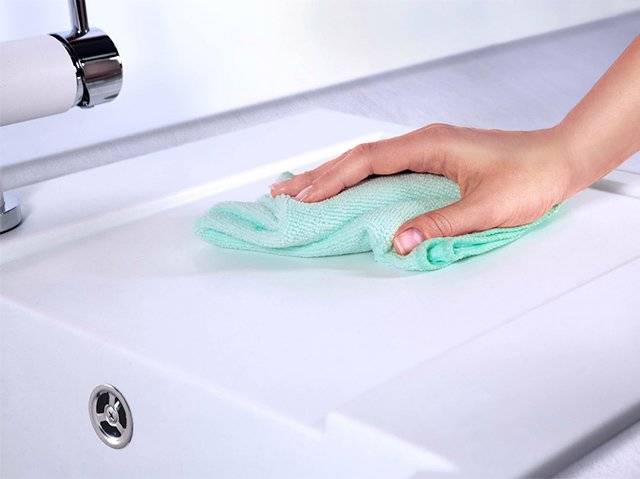
If the sink is heavily soiled, take household bleach and mix with water in a ratio of 3 to 1. The resulting composition is sprayed from a spray bottle, left for 8-12 hours, then washed off with warm water and wiped dry. Do not forget about folk remedies that effectively and safely remove stubborn dirt. First of all, this is lemon and soda.
Tips for caring for your plastic sink in your kitchen
This sink looks stylish and fits well into the modern interior of both the kitchen and the bathroom. In terms of external characteristics, it is not inferior to marble or granite products. However, in order for a composite sink to last a long time, be sure to take into account the basic rules of its operation.
Daily cleaning will help to preserve the original appearance and performance properties. This will keep the stone sink in perfect condition, preventing the formation of large deposits and stubborn stains. However, it should be washed carefully, using only gentle products. At the end of the process, be sure to wipe the entire surface dry with a soft towel.
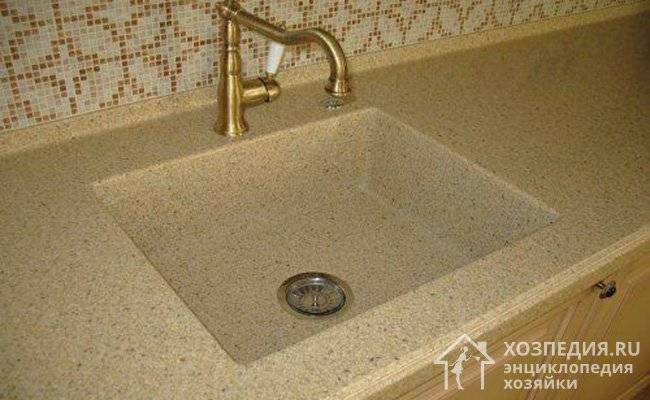 To ensure that the composite sink retains its original appearance for a long time, provide it with proper care.
To ensure that the composite sink retains its original appearance for a long time, provide it with proper care.
Do not throw heavy objects, dishes or cutlery into the sink. This dismissive attitude will lead to scratches or chips. They will clog up dirt, food debris and plaque, which will only complicate the cleaning process. In addition, chipped surfaces look unaesthetic.
Artificial material does not tolerate sudden changes in temperature. Never place pots, pans, or other utensils that have just been removed from the fire on top of the sink. This is hello to cracking or color fading.
Helpful Tips for Sink Care:
- Do not use aggressive substances with abrasive particles and hard scouring pads for cleaning.
- Use the softest cloths to clean. You can also use melamine sponges.
- Rinse the sink after each use and wipe dry.
- Avoid sudden changes in temperature, and do not pour boiling water into the sink or put hot appliances in it.
- Do not use acetone or other solvents for cleaning.
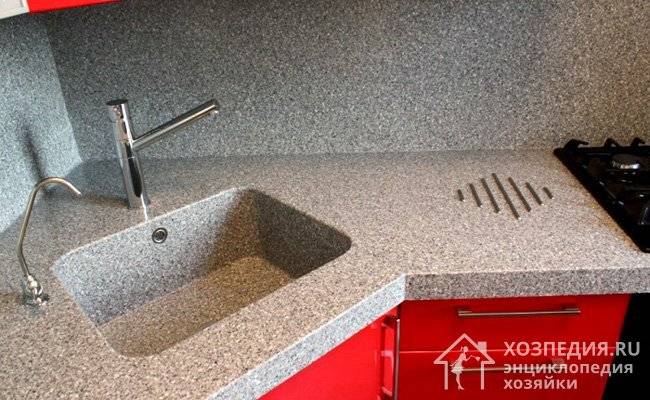 The sink made of composite material is afraid of temperature extremes, shock and exposure to corrosive substances. Use only mild detergents and soft cloths for cleaning.
The sink made of composite material is afraid of temperature extremes, shock and exposure to corrosive substances. Use only mild detergents and soft cloths for cleaning.
Advantages and disadvantages
There are many more advantages than disadvantages
- Artificial stone is not porous The main difference from natural products. Makes it resistant to penetration of grease and moisture, chemical solutions and acids.
- High strength Increased resistance to mechanical stress, clearly exceeding natural indicators.
- Variety of colors Large range. Over 100
- Environmental friendliness Unlike natural materials, artificial stone has an absolutely smooth surface without pores, cracks and cracks. That prevents the formation of microorganisms and pathogens, and as a result of unpleasant odors.
- Repairable Scratches and cuts can be easily repaired. You can drill without worrying that it can crack.
- Color fastness Artificial stone does not fade and retains its original color throughout its entire service life.
- Easy to install the mixer You can install the faucet in any convenient place after assembling the kitchen.
- Durability With proper care, it can last 10 years or more.
Cons:
- High cost Quality sinks from well-known brands are often expensive. Although this disadvantage can be called conditional, since the high cost, as a rule, determines the high quality, and at the same time the durability and convenience.
- Scratches After active movement of pots, pans and other heavy metal utensils, scratches may appear on the surface. One tip: Just be careful.
- Heat resistance Although the material is resistant to boiling water, it is not advisable to place pots directly from the stove, otherwise a print may remain that will not be easy to remove.
Types of stone sinks
Today, there are two types of stone sinks on the plumbing market:
- Acrylic stone such as DuPont's Corian and its counterparts: Samsung has Staron, LG has Hi Macs, a domestic manufacturer of Polygran and Polystone from China. This material consists of a combination of acrylic resins, stone chips and dye. In the production of mixtures, the composition is heated to a high temperature. Depending on the fillers and colorants used, you can achieve a "stone" look for every taste and color. It has excellent environmental qualities, does not absorb moisture and grease, and is resistant to aggressive liquids and acids. With proper care, an item can last for many years. However, it is only possible to integrate an acrylic sink with a countertop made of the same material.
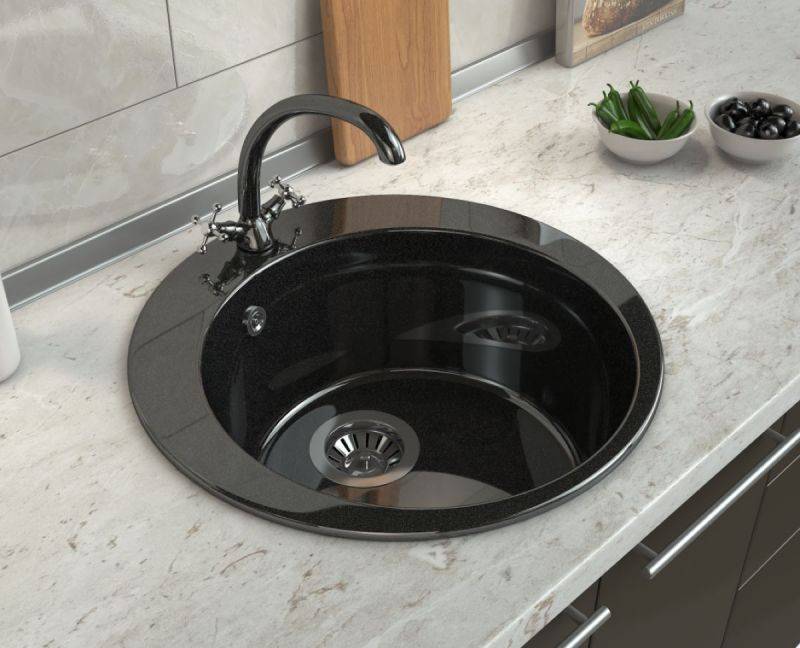
- Granite. In the composition 80 percent is a crumb of natural stone and 20 percent is a binder polymer, including acrylic. The quality is determined by the amount of granite or marble in the composition of this product. It differs from acrylic sinks in appearance and has a grainy color. More durable, not scratched, not afraid of high temperatures. On a granite, marble sink, you can put hot dishes without a special stand, as well as cut food without using a cutting board. Such a sink can be built into a worktop made of any material.
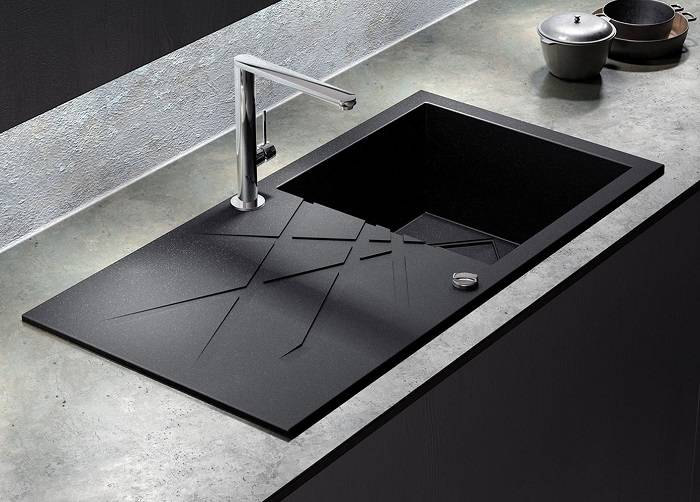
What can not be cleaned composite material
Certain chemicals can damage the composite material. You can not use an active alkali or acid, such as sodium hydroxide or "hodgepodge". If you accidentally spill alcohol or vinegar, rinse the sink. You should not use alcohol for cleaning: it corrodes the paint and leaves ugly light streaks.
The following chemical components are contraindicated:
- solvents;
- any acid;
- acetone;
- methylene chlorine;
- compounds with which metal and ovens are cleaned.
All of these components gradually damage the acrylic stone. When installing the sink, it is unacceptable to insert a silicone seal into the drain hole: it will quickly corrode the paint. Do not clean the composite with metal brushes, coarse sponges or harsh abrasive powders.
Popular folk methods for cleaning stone sinks
By using the right sink cleaner, you can clean it faster than cleaning a sofa that has been inadvertently drenched in juice. Therefore, the key to success in this process is correctly selected cleaning agents, as well as compliance with all instructions for the care of the stone.
This question is of interest to many, the answer is one, of course it is necessary, but to clean not literally. The surface should be cleaned with special gentle agents that are sold in the household chemicals department, they are marked for composites.
- After each use of the sink, it must be rinsed with water and wiped off with a rag so that there are no stains, streaks, this applies especially to black and dark sinks.
- Traces of coffee, beets, natural juices, tea, carbon deposits from the bottom of pans and pots remain on light and snow-white sinks.
- For prevention purposes, the sink is periodically washed with a melamine sponge.
- If a stone product belongs to modern samples and has a protective gelcoat layer, it should be periodically washed with Domestos. This work is carried out every 14-20 days, depending on the degree of contamination, the agent should be applied to the entire surface of the countertop and the working area of the sink.
- Leave on for three minutes and rinse thoroughly with water, can be applied with a sponge or a special brush. Then rinse with water and wipe off all surfaces. During work, it is necessary to put on protective gloves and open the windows, take children and animals out of the room.
Important! The use of Domestos is permitted in cases with persistent dirt, but only for products made of light tones of artificial stone. For black and colored sinks, this detergent can cause irreparable damage.
Stone sinks and sinks, despite their name associated with durability, are not particularly practical and resistant to the influence of various factors. Unlike sanitary ware made of stainless steel, products made of polymer-based composite material are unstable to temperature extremes, coloration of coffee, tea, juices of berries, vegetables, and fruits.
The inconvenience can be avoided by following simple rules for the operation of stone sinks. You can clean the sanitary ware, which looks like a product made of granite stone or marble, using household chemicals or folk methods.
Baking soda is a versatile substance used by housewives in many areas of everyday life. If you add a small amount of water to the white powder and rub the surface of the sink with the resulting gruel, you can wash it from dark spots, soapy streaks, salt deposits, oily deposits.
When rubbing the sink with sodium bicarbonate, it is important not to overdo it, so as not to leave traces of abrasion, scratches
Mustard powder does a great job with grease on plumbing in the kitchen. It can be used neat or mixed in equal proportions with baking soda. A paste is prepared from the powder with warm water and applied to the places of contamination, lightly rubbed with a sponge, and washed off with running water.
Citric acid is an organic chemical compound that even delicate surfaces are not afraid of. Dark areas due to exposure to coffee or tea, yellowness, salt deposits, streaks and streaks can be removed by rubbing the problem area with a slice of citrus fruit. On more stubborn dirt, you can leave lemon juice for 10-20 minutes, and then rinse the surface with warm water.
Table vinegar 9% or an aqueous solution of acetic acid 70-80% will help clean the old stone sink from dark spots and lime deposits. Vinegar 9% is diluted with water in a ratio of 3: 1, and acid is diluted 1:10. A sponge is moistened in the finished solution, and the place of pollution is rubbed with the rough side. At the end of the procedure, the plumber is rinsed with warm running water.
We are talking about Coca-Cola, which copes well with rust and salt deposits. The drain hole of the sink is closed with a plug, a drink is poured into the product and left for half an hour. The edges, the top of the sink must be moistened with a sponge. After the expiration of time, the liquid is drained, and the surface is washed with water.
Toothpaste and powder are great cleanser alternatives. They will remove dirt, refresh the product with a pleasant aroma. A little paste is squeezed onto the sponge or powder is poured, after which the problem area is rubbed, and then washed off.
Properties and advantages of artificial stone
The basis for the manufacture of artificial stone is small chips, which are glued together with polymer resins. When creating sinks and other products, different types of chips are used, for example, granite or quartz. Coloring is carried out with dyes consisting of mineral pigments.
Information!
Composite materials are safe in contact with kitchen utensils and food.
After the mixture hardens, it turns into a reliable composite material. He possesses:
- homogeneous structure.Due to its uniformity, the product looks solid and monolithic;
- high strength. Such a sink does not make noise when it comes into contact with water, it is easy to clean.
- resistance to heat. It is undesirable to heat the sinks too much, but they can withstand high temperatures up to certain limits;
- UV resistant. In direct sunlight, the material is not subject to fading;
- hygiene. The substances that make up the composite are regularly checked.
Artificial stone properties
Stone kitchen products are popular not only for their attractive appearance, but also for their excellent performance characteristics. They are safe for human health, durable and quite durable. Composite sinks are unpretentious to maintain, but still require adherence to some recommendations for use and cleaning.
Constant companions of light-colored sinks are stains from coffee, tea, vegetables and other coloring products. And the main scourge of dark shells is limescale.
Constant companions of light-colored sinks are stains from coffee, tea, vegetables and other coloring products. And the main scourge of dark shells is limescale.
How to wash?
An urgent question for housewives trying to maintain the beauty and appearance of plumbing in the kitchen. To prevent pollution from catching you "by surprise", it is better to have in your arsenal in advance means and preparations for removing stains. If special household chemicals are not at hand, and the stain still appears, we will use the home remedies available in the kitchen.
Melamine sponge
A light sink is afraid of dark stains and dirt, while dark products, on the contrary, suffer from white limescale, so a melamine sponge will be a good helper for you. If you have it in your kitchen, just try rubbing the stain with water without using any additional products or powders. If the mud or limescale does not lend itself, we begin to connect special or household detergents.

Melamine sponge
Mustard powder
A simple, inexpensive product. Perfectly removes grease and dirt, neutralizing them. Mix with water until a slurry is formed, treat the surface in a circular motion until completely clean. At the end of the procedure, rinse with water and wipe dry.
Lemon acid
A citric acid solution is suitable for tough tea or coffee stains. To achieve the result, we wet the place of contamination with a solution and give time for the acid to dissolve the plaque. Then wash off with water using a sponge.
Vinegar
With a sponge dipped in 9% table vinegar, we treat complex contaminants such as from tea, coffee, beets or red wine. After a 3-5 minute pause, rinse off the solution, while disinfecting.
Toothpaste
In cases with a light shell, especially a white one, you can use a toothpaste, preferably gel, to remove dark spots. We wipe it off with the same melamine sponge until the sink turns white.
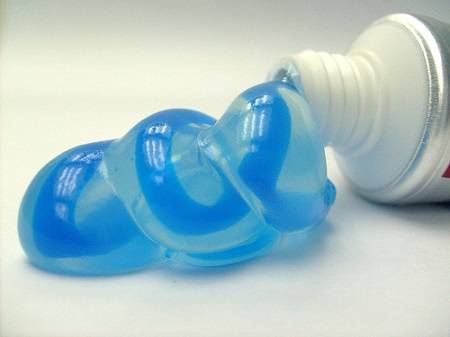
Chlorine based products
Household chemicals based on chlorine, such as Whiteness, Domestos will not damage an artificial stone product, and will save you from stubborn dirt. When removing stains of rust and yellowness, we boldly use them for their intended purpose. To do this, apply the cleaning agent to the dirt and leave it for a few minutes, then rinse it off with running water. Chlorine-based cleaners can not only clean and bleach surfaces well, but also disinfect well.

Detergents with chlorine for cleaning and disinfection
Soda
When cleaning stubborn stains, it is possible to use abrasive products. For example Soda, or Comets. Before starting work, we dilute the soda with water until a gruel forms, treat the stain for 10-15 minutes without rubbing. Then we wash it off with water and scrub it with a sponge until it is completely clean.
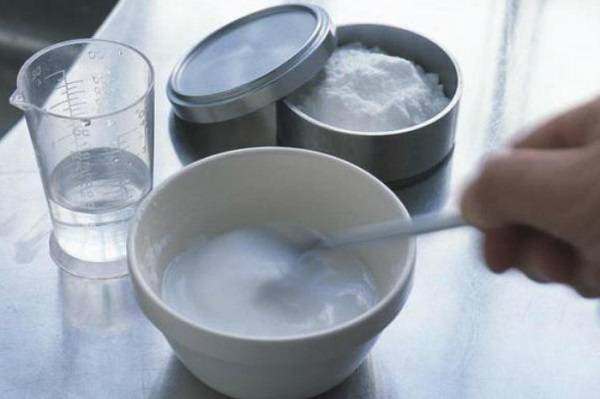
Gruel from a mixture of soda and water to remove stains on the sink
Wash off with Coca-Cola
It is believed that you can remove dark spots using carbonated drinks such as: Coca-Cola, Seven-up or Sprite. Indeed, the phosphoric acid included in their composition is capable of dissolving dirt, and even in combination with gas bubbles, which, when collapsing, form a cavitation effect used for cleaning in different areas. However, the capabilities of this "folk" detergent are greatly exaggerated.
Conclusion
Artificial stone is an excellent material for making products for the bathroom and kitchen, as it has excellent decorative and hygienic properties. However, caring for items made from such capricious materials can be difficult and time-consuming and energy-intensive. However, cleaning even the most difficult dirt is possible. And in order to reduce the number of general cleanings, it is recommended to carry out preventive measures in a timely manner and prevent deformation of the stone.
Video: what is the best way to launder?

